Computerised Accounting in an ERP
VerifiedAdded on 2023/06/03
|18
|4313
|324
AI Summary
This report explores the historical overview of SAP S/4HANA finance, the differences between SAP S/4HANA finance and SAP ERP FICO, and the benefits of using SAP S/4HANA for business purposes. It also includes case studies of entities that have migrated to SAP S/4HANA and discusses the issues they faced. The report concludes with findings and discussions.
Contribute Materials
Your contribution can guide someone’s learning journey. Share your
documents today.
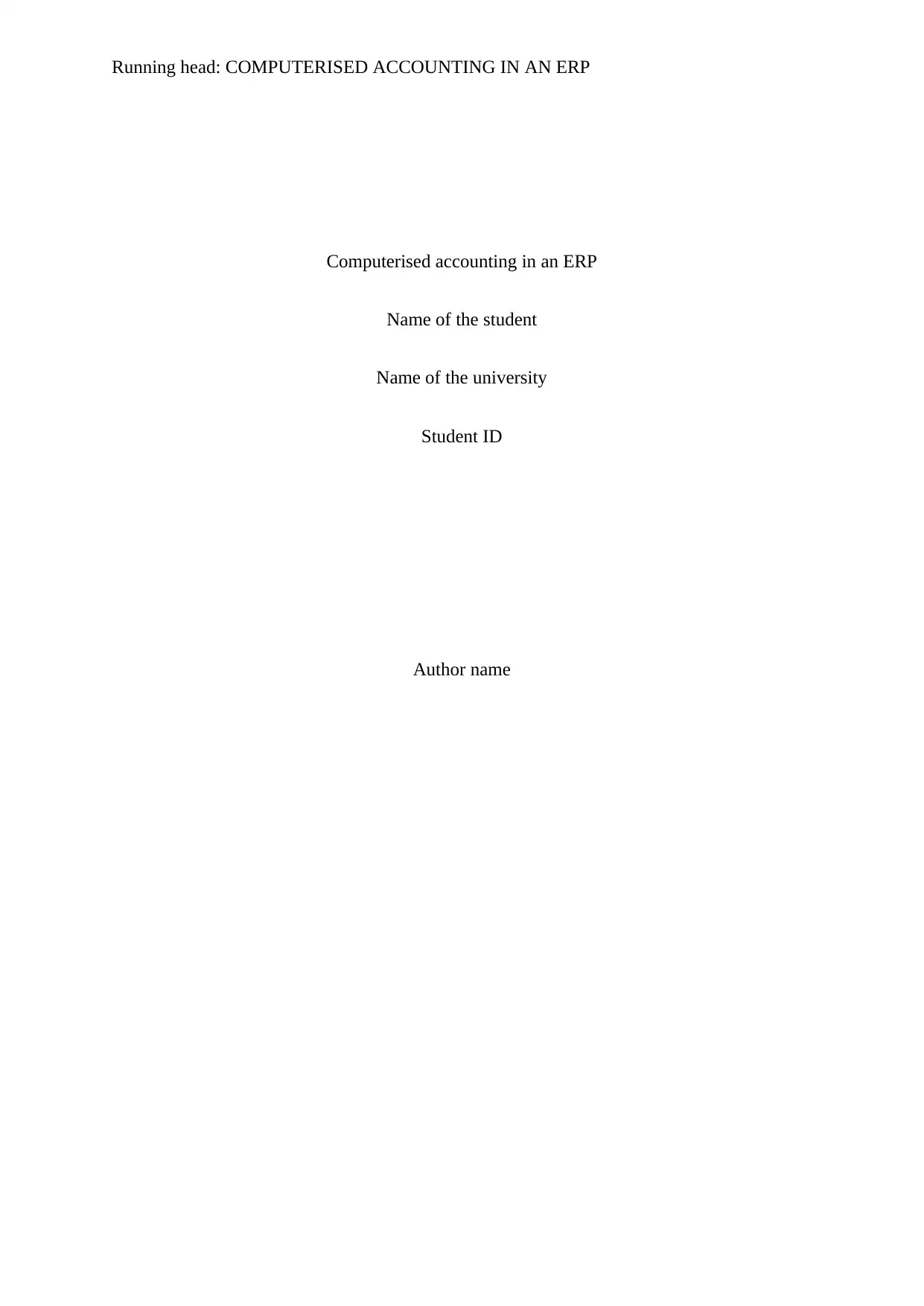
Running head: COMPUTERISED ACCOUNTING IN AN ERP
Computerised accounting in an ERP
Name of the student
Name of the university
Student ID
Author name
Computerised accounting in an ERP
Name of the student
Name of the university
Student ID
Author name
Secure Best Marks with AI Grader
Need help grading? Try our AI Grader for instant feedback on your assignments.
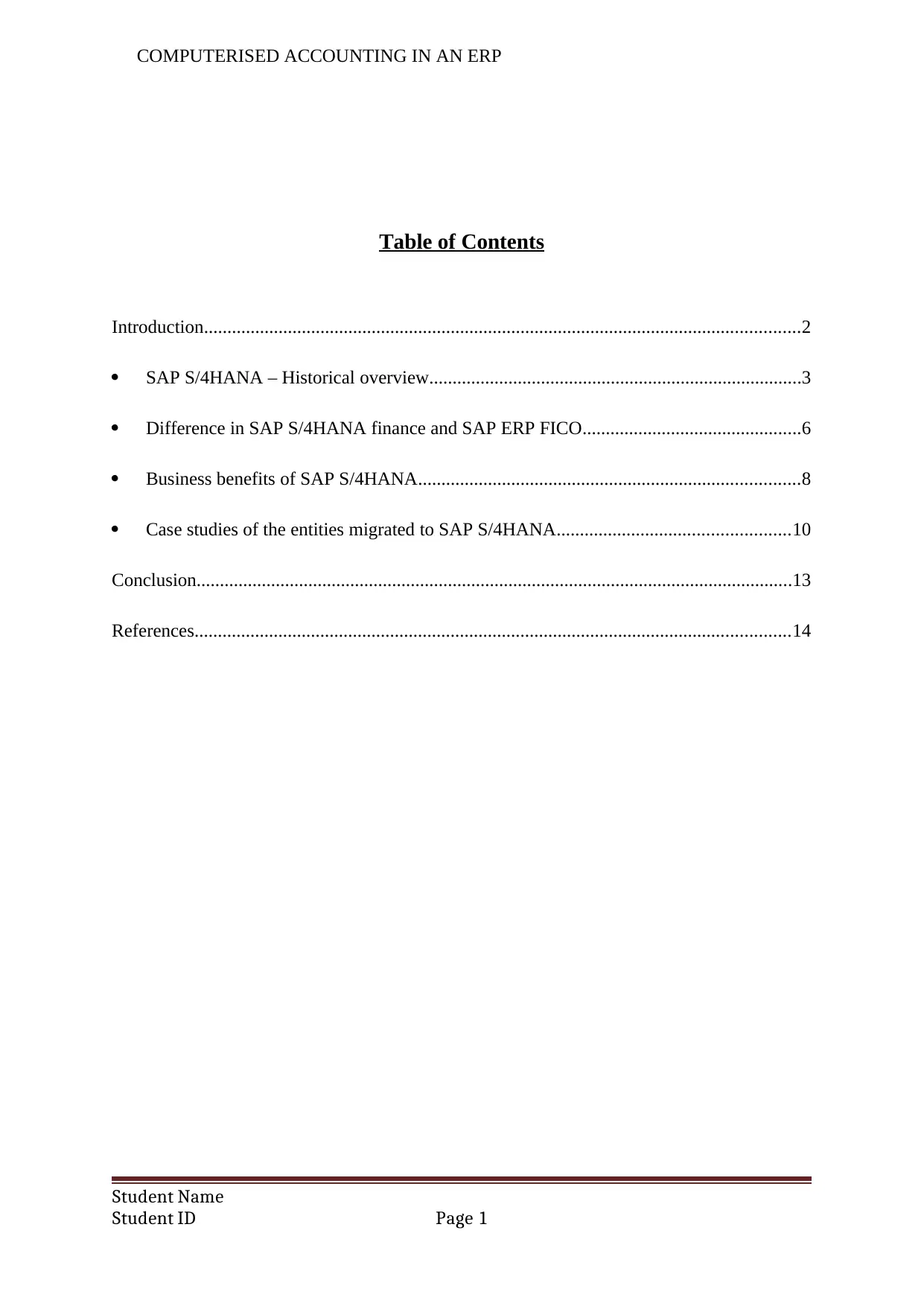
COMPUTERISED ACCOUNTING IN AN ERP
Table of Contents
Introduction................................................................................................................................2
SAP S/4HANA – Historical overview................................................................................3
Difference in SAP S/4HANA finance and SAP ERP FICO...............................................6
Business benefits of SAP S/4HANA..................................................................................8
Case studies of the entities migrated to SAP S/4HANA..................................................10
Conclusion................................................................................................................................13
References................................................................................................................................14
Student Name
Student ID Page 1
Table of Contents
Introduction................................................................................................................................2
SAP S/4HANA – Historical overview................................................................................3
Difference in SAP S/4HANA finance and SAP ERP FICO...............................................6
Business benefits of SAP S/4HANA..................................................................................8
Case studies of the entities migrated to SAP S/4HANA..................................................10
Conclusion................................................................................................................................13
References................................................................................................................................14
Student Name
Student ID Page 1
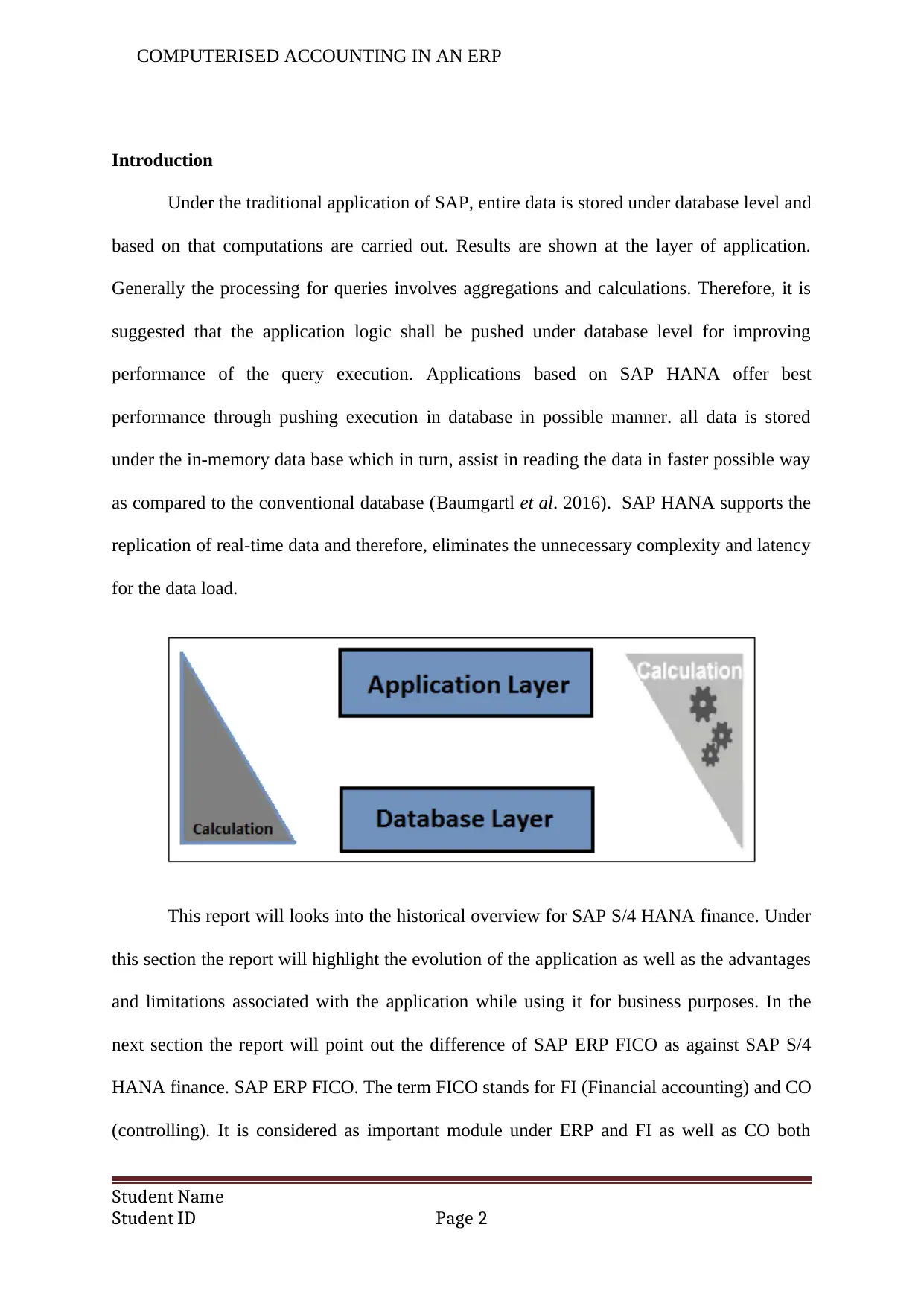
COMPUTERISED ACCOUNTING IN AN ERP
Introduction
Under the traditional application of SAP, entire data is stored under database level and
based on that computations are carried out. Results are shown at the layer of application.
Generally the processing for queries involves aggregations and calculations. Therefore, it is
suggested that the application logic shall be pushed under database level for improving
performance of the query execution. Applications based on SAP HANA offer best
performance through pushing execution in database in possible manner. all data is stored
under the in-memory data base which in turn, assist in reading the data in faster possible way
as compared to the conventional database (Baumgartl et al. 2016). SAP HANA supports the
replication of real-time data and therefore, eliminates the unnecessary complexity and latency
for the data load.
This report will looks into the historical overview for SAP S/4 HANA finance. Under
this section the report will highlight the evolution of the application as well as the advantages
and limitations associated with the application while using it for business purposes. In the
next section the report will point out the difference of SAP ERP FICO as against SAP S/4
HANA finance. SAP ERP FICO. The term FICO stands for FI (Financial accounting) and CO
(controlling). It is considered as important module under ERP and FI as well as CO both
Student Name
Student ID Page 2
Introduction
Under the traditional application of SAP, entire data is stored under database level and
based on that computations are carried out. Results are shown at the layer of application.
Generally the processing for queries involves aggregations and calculations. Therefore, it is
suggested that the application logic shall be pushed under database level for improving
performance of the query execution. Applications based on SAP HANA offer best
performance through pushing execution in database in possible manner. all data is stored
under the in-memory data base which in turn, assist in reading the data in faster possible way
as compared to the conventional database (Baumgartl et al. 2016). SAP HANA supports the
replication of real-time data and therefore, eliminates the unnecessary complexity and latency
for the data load.
This report will looks into the historical overview for SAP S/4 HANA finance. Under
this section the report will highlight the evolution of the application as well as the advantages
and limitations associated with the application while using it for business purposes. In the
next section the report will point out the difference of SAP ERP FICO as against SAP S/4
HANA finance. SAP ERP FICO. The term FICO stands for FI (Financial accounting) and CO
(controlling). It is considered as important module under ERP and FI as well as CO both
Student Name
Student ID Page 2
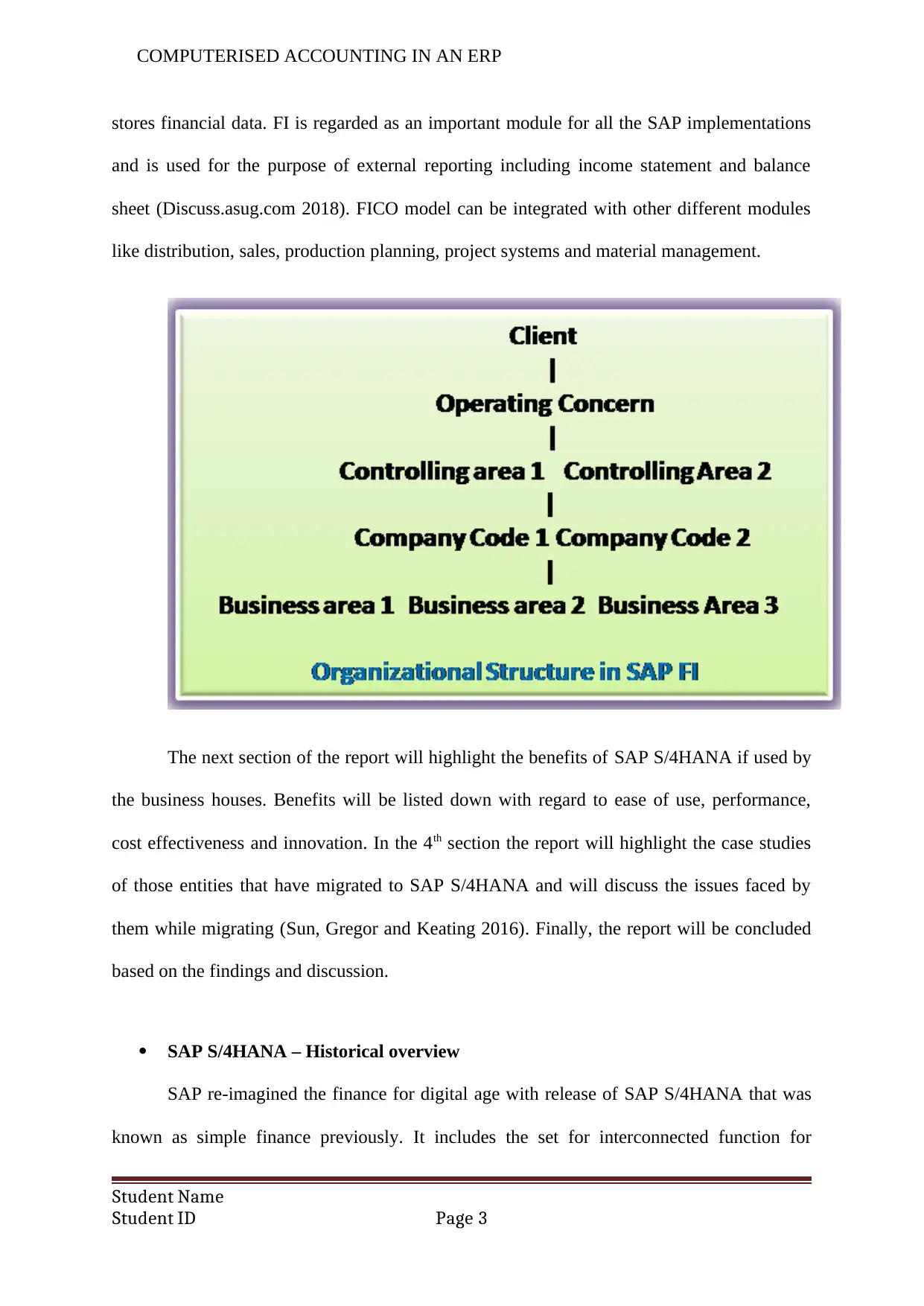
COMPUTERISED ACCOUNTING IN AN ERP
stores financial data. FI is regarded as an important module for all the SAP implementations
and is used for the purpose of external reporting including income statement and balance
sheet (Discuss.asug.com 2018). FICO model can be integrated with other different modules
like distribution, sales, production planning, project systems and material management.
The next section of the report will highlight the benefits of SAP S/4HANA if used by
the business houses. Benefits will be listed down with regard to ease of use, performance,
cost effectiveness and innovation. In the 4th section the report will highlight the case studies
of those entities that have migrated to SAP S/4HANA and will discuss the issues faced by
them while migrating (Sun, Gregor and Keating 2016). Finally, the report will be concluded
based on the findings and discussion.
SAP S/4HANA – Historical overview
SAP re-imagined the finance for digital age with release of SAP S/4HANA that was
known as simple finance previously. It includes the set for interconnected function for
Student Name
Student ID Page 3
stores financial data. FI is regarded as an important module for all the SAP implementations
and is used for the purpose of external reporting including income statement and balance
sheet (Discuss.asug.com 2018). FICO model can be integrated with other different modules
like distribution, sales, production planning, project systems and material management.
The next section of the report will highlight the benefits of SAP S/4HANA if used by
the business houses. Benefits will be listed down with regard to ease of use, performance,
cost effectiveness and innovation. In the 4th section the report will highlight the case studies
of those entities that have migrated to SAP S/4HANA and will discuss the issues faced by
them while migrating (Sun, Gregor and Keating 2016). Finally, the report will be concluded
based on the findings and discussion.
SAP S/4HANA – Historical overview
SAP re-imagined the finance for digital age with release of SAP S/4HANA that was
known as simple finance previously. It includes the set for interconnected function for
Student Name
Student ID Page 3
Secure Best Marks with AI Grader
Need help grading? Try our AI Grader for instant feedback on your assignments.
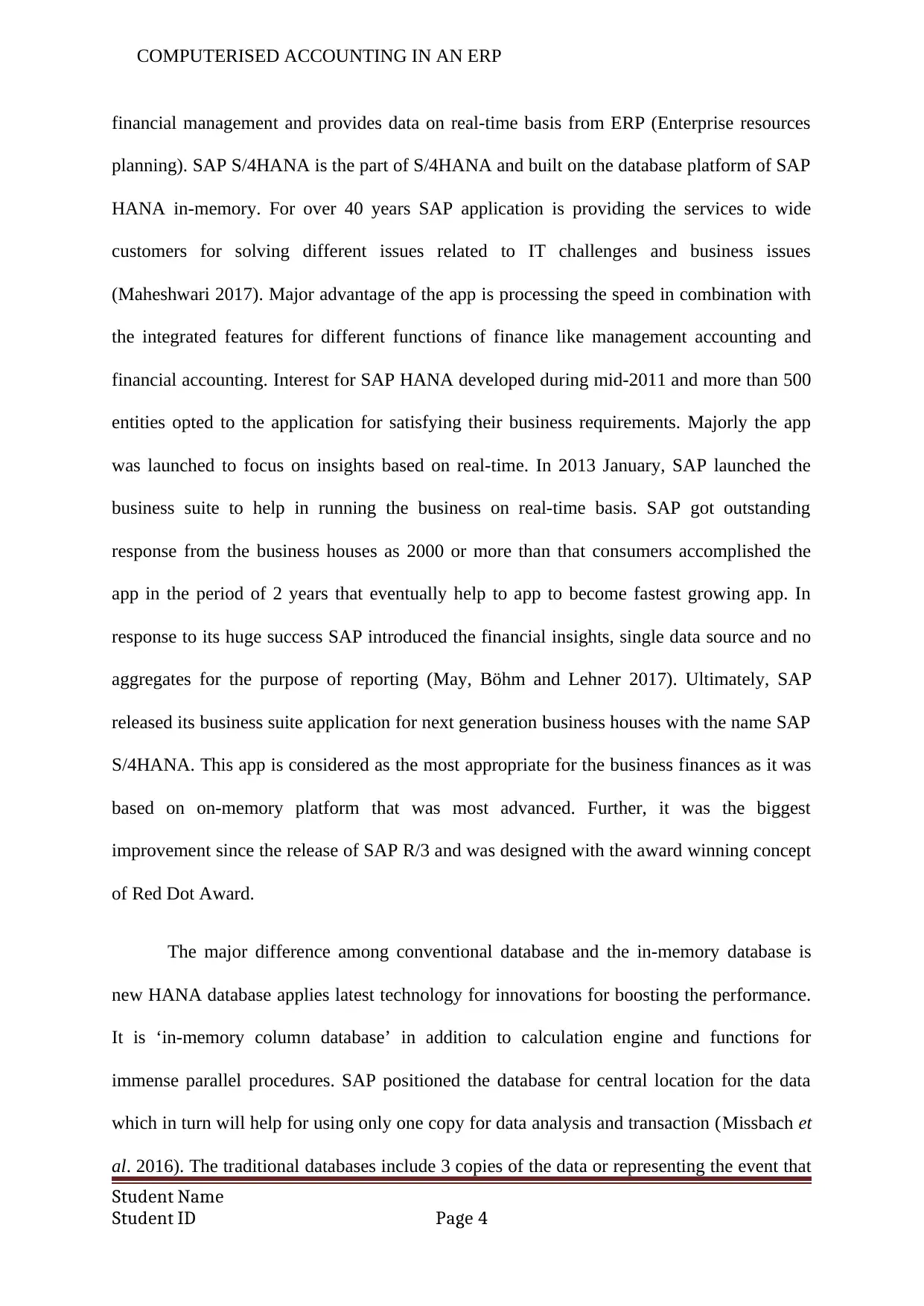
COMPUTERISED ACCOUNTING IN AN ERP
financial management and provides data on real-time basis from ERP (Enterprise resources
planning). SAP S/4HANA is the part of S/4HANA and built on the database platform of SAP
HANA in-memory. For over 40 years SAP application is providing the services to wide
customers for solving different issues related to IT challenges and business issues
(Maheshwari 2017). Major advantage of the app is processing the speed in combination with
the integrated features for different functions of finance like management accounting and
financial accounting. Interest for SAP HANA developed during mid-2011 and more than 500
entities opted to the application for satisfying their business requirements. Majorly the app
was launched to focus on insights based on real-time. In 2013 January, SAP launched the
business suite to help in running the business on real-time basis. SAP got outstanding
response from the business houses as 2000 or more than that consumers accomplished the
app in the period of 2 years that eventually help to app to become fastest growing app. In
response to its huge success SAP introduced the financial insights, single data source and no
aggregates for the purpose of reporting (May, Böhm and Lehner 2017) . Ultimately, SAP
released its business suite application for next generation business houses with the name SAP
S/4HANA. This app is considered as the most appropriate for the business finances as it was
based on on-memory platform that was most advanced. Further, it was the biggest
improvement since the release of SAP R/3 and was designed with the award winning concept
of Red Dot Award.
The major difference among conventional database and the in-memory database is
new HANA database applies latest technology for innovations for boosting the performance.
It is ‘in-memory column database’ in addition to calculation engine and functions for
immense parallel procedures. SAP positioned the database for central location for the data
which in turn will help for using only one copy for data analysis and transaction (Missbach et
al. 2016). The traditional databases include 3 copies of the data or representing the event that
Student Name
Student ID Page 4
financial management and provides data on real-time basis from ERP (Enterprise resources
planning). SAP S/4HANA is the part of S/4HANA and built on the database platform of SAP
HANA in-memory. For over 40 years SAP application is providing the services to wide
customers for solving different issues related to IT challenges and business issues
(Maheshwari 2017). Major advantage of the app is processing the speed in combination with
the integrated features for different functions of finance like management accounting and
financial accounting. Interest for SAP HANA developed during mid-2011 and more than 500
entities opted to the application for satisfying their business requirements. Majorly the app
was launched to focus on insights based on real-time. In 2013 January, SAP launched the
business suite to help in running the business on real-time basis. SAP got outstanding
response from the business houses as 2000 or more than that consumers accomplished the
app in the period of 2 years that eventually help to app to become fastest growing app. In
response to its huge success SAP introduced the financial insights, single data source and no
aggregates for the purpose of reporting (May, Böhm and Lehner 2017) . Ultimately, SAP
released its business suite application for next generation business houses with the name SAP
S/4HANA. This app is considered as the most appropriate for the business finances as it was
based on on-memory platform that was most advanced. Further, it was the biggest
improvement since the release of SAP R/3 and was designed with the award winning concept
of Red Dot Award.
The major difference among conventional database and the in-memory database is
new HANA database applies latest technology for innovations for boosting the performance.
It is ‘in-memory column database’ in addition to calculation engine and functions for
immense parallel procedures. SAP positioned the database for central location for the data
which in turn will help for using only one copy for data analysis and transaction (Missbach et
al. 2016). The traditional databases include 3 copies of the data or representing the event that
Student Name
Student ID Page 4
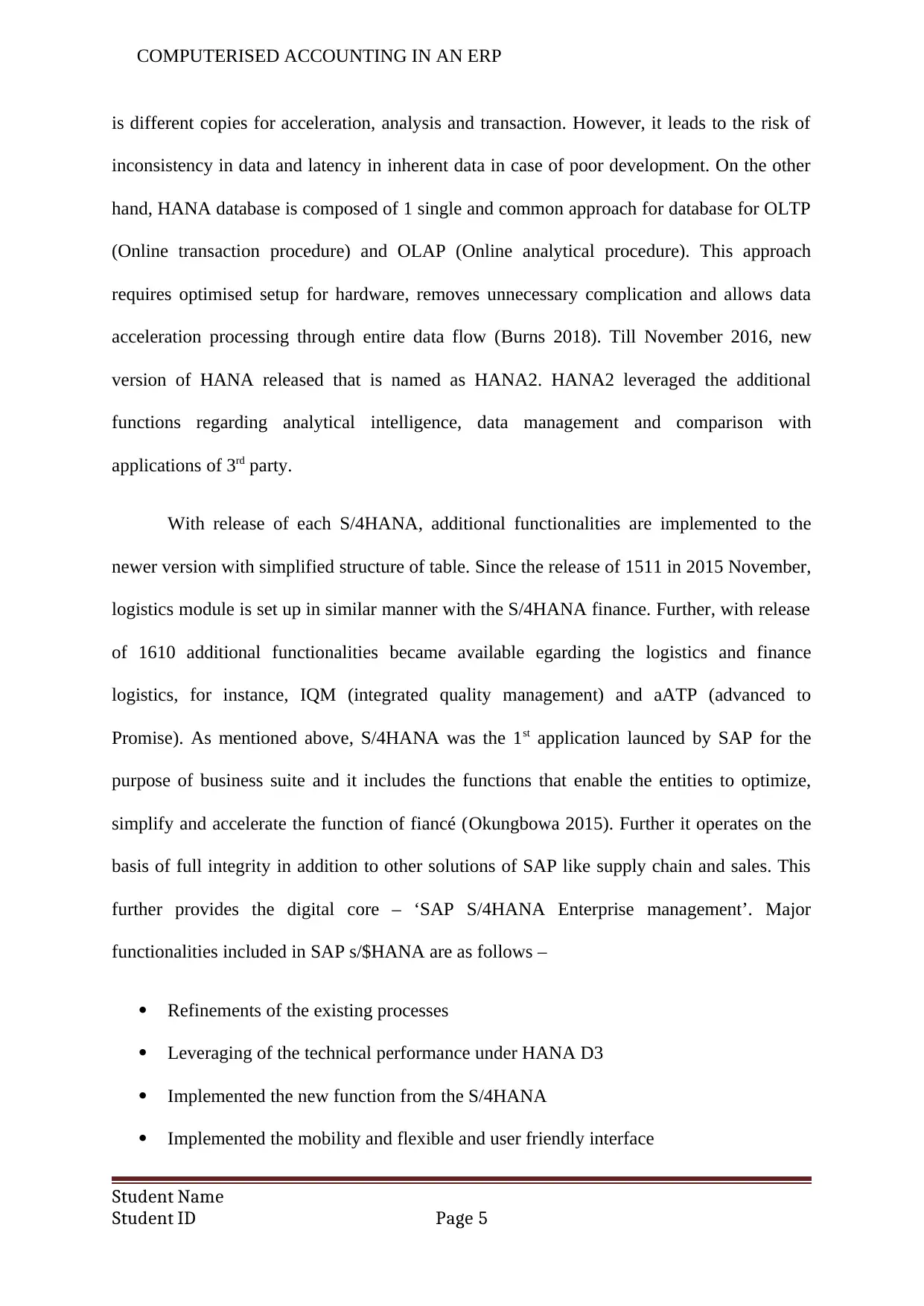
COMPUTERISED ACCOUNTING IN AN ERP
is different copies for acceleration, analysis and transaction. However, it leads to the risk of
inconsistency in data and latency in inherent data in case of poor development. On the other
hand, HANA database is composed of 1 single and common approach for database for OLTP
(Online transaction procedure) and OLAP (Online analytical procedure). This approach
requires optimised setup for hardware, removes unnecessary complication and allows data
acceleration processing through entire data flow (Burns 2018). Till November 2016, new
version of HANA released that is named as HANA2. HANA2 leveraged the additional
functions regarding analytical intelligence, data management and comparison with
applications of 3rd party.
With release of each S/4HANA, additional functionalities are implemented to the
newer version with simplified structure of table. Since the release of 1511 in 2015 November,
logistics module is set up in similar manner with the S/4HANA finance. Further, with release
of 1610 additional functionalities became available egarding the logistics and finance
logistics, for instance, IQM (integrated quality management) and aATP (advanced to
Promise). As mentioned above, S/4HANA was the 1st application launced by SAP for the
purpose of business suite and it includes the functions that enable the entities to optimize,
simplify and accelerate the function of fiancé (Okungbowa 2015). Further it operates on the
basis of full integrity in addition to other solutions of SAP like supply chain and sales. This
further provides the digital core – ‘SAP S/4HANA Enterprise management’. Major
functionalities included in SAP s/$HANA are as follows –
Refinements of the existing processes
Leveraging of the technical performance under HANA D3
Implemented the new function from the S/4HANA
Implemented the mobility and flexible and user friendly interface
Student Name
Student ID Page 5
is different copies for acceleration, analysis and transaction. However, it leads to the risk of
inconsistency in data and latency in inherent data in case of poor development. On the other
hand, HANA database is composed of 1 single and common approach for database for OLTP
(Online transaction procedure) and OLAP (Online analytical procedure). This approach
requires optimised setup for hardware, removes unnecessary complication and allows data
acceleration processing through entire data flow (Burns 2018). Till November 2016, new
version of HANA released that is named as HANA2. HANA2 leveraged the additional
functions regarding analytical intelligence, data management and comparison with
applications of 3rd party.
With release of each S/4HANA, additional functionalities are implemented to the
newer version with simplified structure of table. Since the release of 1511 in 2015 November,
logistics module is set up in similar manner with the S/4HANA finance. Further, with release
of 1610 additional functionalities became available egarding the logistics and finance
logistics, for instance, IQM (integrated quality management) and aATP (advanced to
Promise). As mentioned above, S/4HANA was the 1st application launced by SAP for the
purpose of business suite and it includes the functions that enable the entities to optimize,
simplify and accelerate the function of fiancé (Okungbowa 2015). Further it operates on the
basis of full integrity in addition to other solutions of SAP like supply chain and sales. This
further provides the digital core – ‘SAP S/4HANA Enterprise management’. Major
functionalities included in SAP s/$HANA are as follows –
Refinements of the existing processes
Leveraging of the technical performance under HANA D3
Implemented the new function from the S/4HANA
Implemented the mobility and flexible and user friendly interface
Student Name
Student ID Page 5
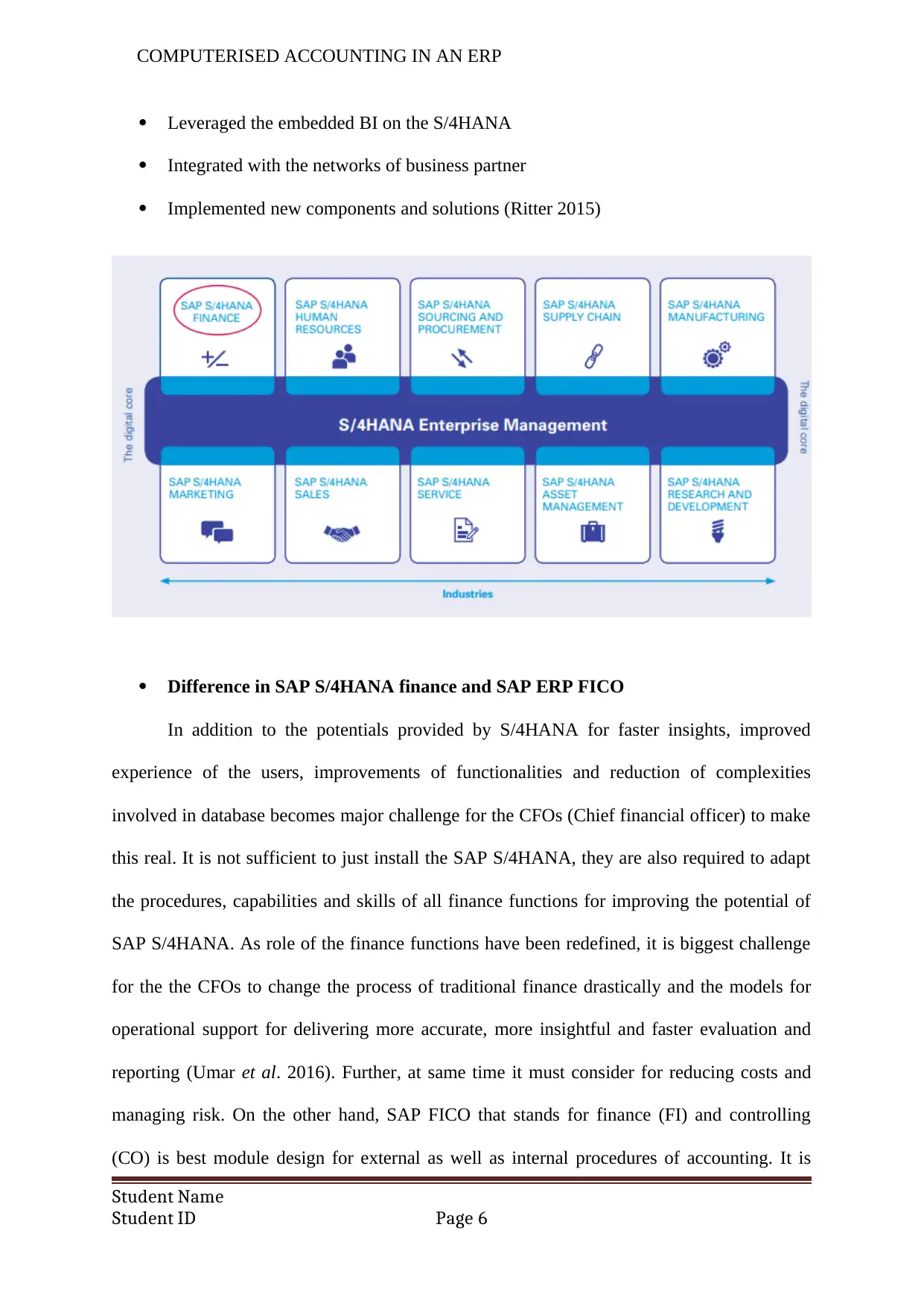
COMPUTERISED ACCOUNTING IN AN ERP
Leveraged the embedded BI on the S/4HANA
Integrated with the networks of business partner
Implemented new components and solutions (Ritter 2015)
Difference in SAP S/4HANA finance and SAP ERP FICO
In addition to the potentials provided by S/4HANA for faster insights, improved
experience of the users, improvements of functionalities and reduction of complexities
involved in database becomes major challenge for the CFOs (Chief financial officer) to make
this real. It is not sufficient to just install the SAP S/4HANA, they are also required to adapt
the procedures, capabilities and skills of all finance functions for improving the potential of
SAP S/4HANA. As role of the finance functions have been redefined, it is biggest challenge
for the the CFOs to change the process of traditional finance drastically and the models for
operational support for delivering more accurate, more insightful and faster evaluation and
reporting (Umar et al. 2016). Further, at same time it must consider for reducing costs and
managing risk. On the other hand, SAP FICO that stands for finance (FI) and controlling
(CO) is best module design for external as well as internal procedures of accounting. It is
Student Name
Student ID Page 6
Leveraged the embedded BI on the S/4HANA
Integrated with the networks of business partner
Implemented new components and solutions (Ritter 2015)
Difference in SAP S/4HANA finance and SAP ERP FICO
In addition to the potentials provided by S/4HANA for faster insights, improved
experience of the users, improvements of functionalities and reduction of complexities
involved in database becomes major challenge for the CFOs (Chief financial officer) to make
this real. It is not sufficient to just install the SAP S/4HANA, they are also required to adapt
the procedures, capabilities and skills of all finance functions for improving the potential of
SAP S/4HANA. As role of the finance functions have been redefined, it is biggest challenge
for the the CFOs to change the process of traditional finance drastically and the models for
operational support for delivering more accurate, more insightful and faster evaluation and
reporting (Umar et al. 2016). Further, at same time it must consider for reducing costs and
managing risk. On the other hand, SAP FICO that stands for finance (FI) and controlling
(CO) is best module design for external as well as internal procedures of accounting. It is
Student Name
Student ID Page 6
Paraphrase This Document
Need a fresh take? Get an instant paraphrase of this document with our AI Paraphraser
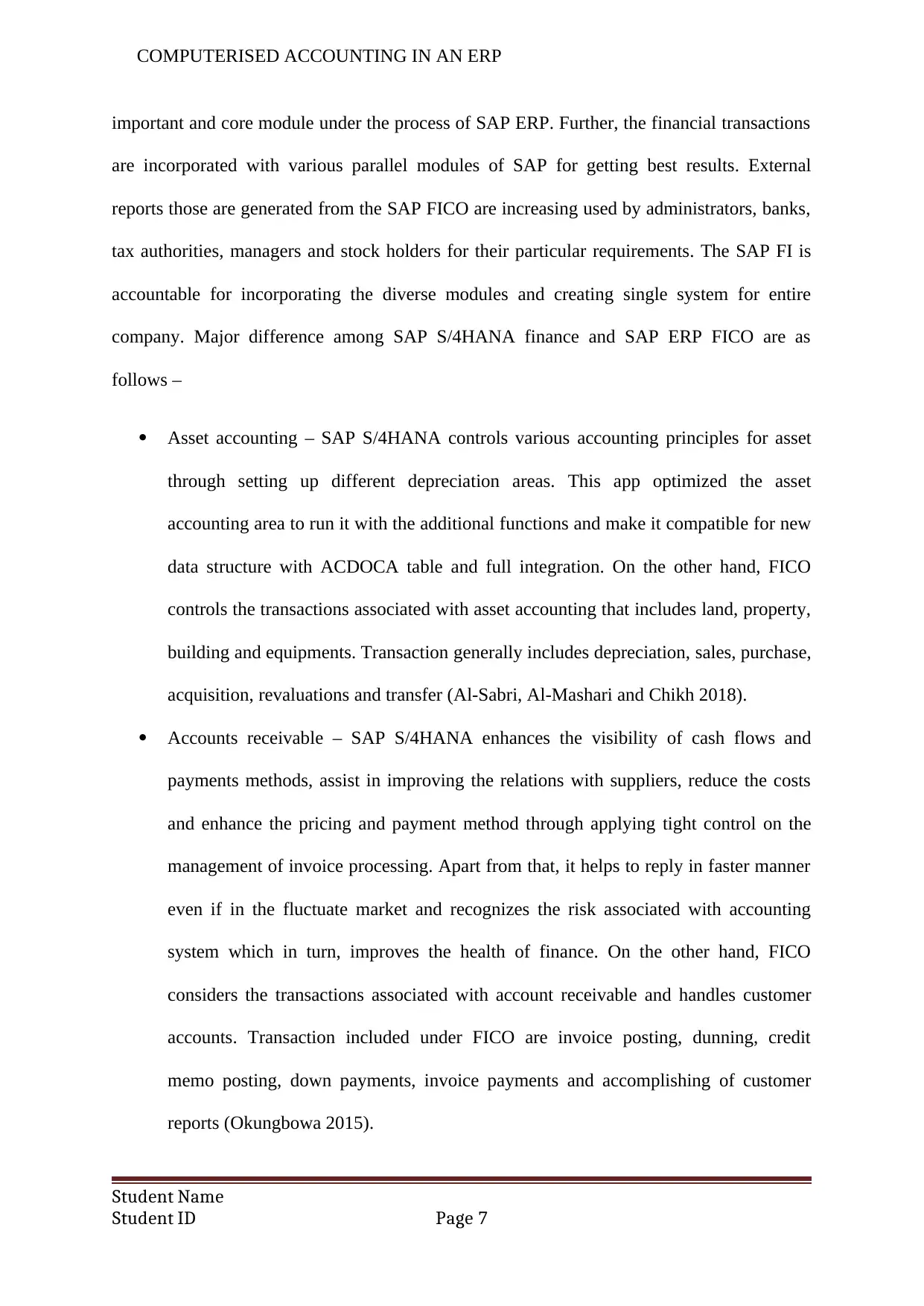
COMPUTERISED ACCOUNTING IN AN ERP
important and core module under the process of SAP ERP. Further, the financial transactions
are incorporated with various parallel modules of SAP for getting best results. External
reports those are generated from the SAP FICO are increasing used by administrators, banks,
tax authorities, managers and stock holders for their particular requirements. The SAP FI is
accountable for incorporating the diverse modules and creating single system for entire
company. Major difference among SAP S/4HANA finance and SAP ERP FICO are as
follows –
Asset accounting – SAP S/4HANA controls various accounting principles for asset
through setting up different depreciation areas. This app optimized the asset
accounting area to run it with the additional functions and make it compatible for new
data structure with ACDOCA table and full integration. On the other hand, FICO
controls the transactions associated with asset accounting that includes land, property,
building and equipments. Transaction generally includes depreciation, sales, purchase,
acquisition, revaluations and transfer (Al-Sabri, Al-Mashari and Chikh 2018).
Accounts receivable – SAP S/4HANA enhances the visibility of cash flows and
payments methods, assist in improving the relations with suppliers, reduce the costs
and enhance the pricing and payment method through applying tight control on the
management of invoice processing. Apart from that, it helps to reply in faster manner
even if in the fluctuate market and recognizes the risk associated with accounting
system which in turn, improves the health of finance. On the other hand, FICO
considers the transactions associated with account receivable and handles customer
accounts. Transaction included under FICO are invoice posting, dunning, credit
memo posting, down payments, invoice payments and accomplishing of customer
reports (Okungbowa 2015).
Student Name
Student ID Page 7
important and core module under the process of SAP ERP. Further, the financial transactions
are incorporated with various parallel modules of SAP for getting best results. External
reports those are generated from the SAP FICO are increasing used by administrators, banks,
tax authorities, managers and stock holders for their particular requirements. The SAP FI is
accountable for incorporating the diverse modules and creating single system for entire
company. Major difference among SAP S/4HANA finance and SAP ERP FICO are as
follows –
Asset accounting – SAP S/4HANA controls various accounting principles for asset
through setting up different depreciation areas. This app optimized the asset
accounting area to run it with the additional functions and make it compatible for new
data structure with ACDOCA table and full integration. On the other hand, FICO
controls the transactions associated with asset accounting that includes land, property,
building and equipments. Transaction generally includes depreciation, sales, purchase,
acquisition, revaluations and transfer (Al-Sabri, Al-Mashari and Chikh 2018).
Accounts receivable – SAP S/4HANA enhances the visibility of cash flows and
payments methods, assist in improving the relations with suppliers, reduce the costs
and enhance the pricing and payment method through applying tight control on the
management of invoice processing. Apart from that, it helps to reply in faster manner
even if in the fluctuate market and recognizes the risk associated with accounting
system which in turn, improves the health of finance. On the other hand, FICO
considers the transactions associated with account receivable and handles customer
accounts. Transaction included under FICO are invoice posting, dunning, credit
memo posting, down payments, invoice payments and accomplishing of customer
reports (Okungbowa 2015).
Student Name
Student ID Page 7
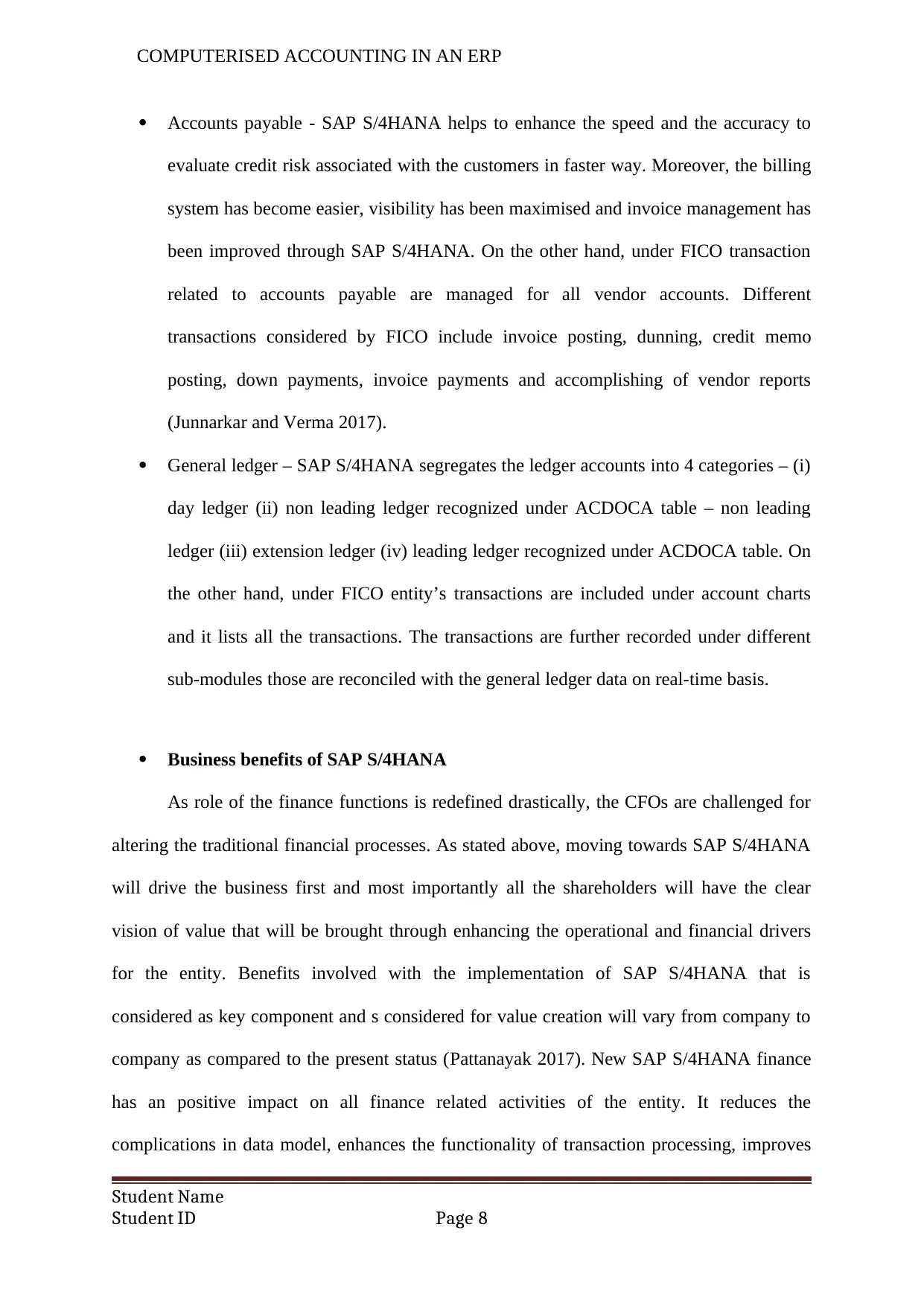
COMPUTERISED ACCOUNTING IN AN ERP
Accounts payable - SAP S/4HANA helps to enhance the speed and the accuracy to
evaluate credit risk associated with the customers in faster way. Moreover, the billing
system has become easier, visibility has been maximised and invoice management has
been improved through SAP S/4HANA. On the other hand, under FICO transaction
related to accounts payable are managed for all vendor accounts. Different
transactions considered by FICO include invoice posting, dunning, credit memo
posting, down payments, invoice payments and accomplishing of vendor reports
(Junnarkar and Verma 2017).
General ledger – SAP S/4HANA segregates the ledger accounts into 4 categories – (i)
day ledger (ii) non leading ledger recognized under ACDOCA table – non leading
ledger (iii) extension ledger (iv) leading ledger recognized under ACDOCA table. On
the other hand, under FICO entity’s transactions are included under account charts
and it lists all the transactions. The transactions are further recorded under different
sub-modules those are reconciled with the general ledger data on real-time basis.
Business benefits of SAP S/4HANA
As role of the finance functions is redefined drastically, the CFOs are challenged for
altering the traditional financial processes. As stated above, moving towards SAP S/4HANA
will drive the business first and most importantly all the shareholders will have the clear
vision of value that will be brought through enhancing the operational and financial drivers
for the entity. Benefits involved with the implementation of SAP S/4HANA that is
considered as key component and s considered for value creation will vary from company to
company as compared to the present status (Pattanayak 2017). New SAP S/4HANA finance
has an positive impact on all finance related activities of the entity. It reduces the
complications in data model, enhances the functionality of transaction processing, improves
Student Name
Student ID Page 8
Accounts payable - SAP S/4HANA helps to enhance the speed and the accuracy to
evaluate credit risk associated with the customers in faster way. Moreover, the billing
system has become easier, visibility has been maximised and invoice management has
been improved through SAP S/4HANA. On the other hand, under FICO transaction
related to accounts payable are managed for all vendor accounts. Different
transactions considered by FICO include invoice posting, dunning, credit memo
posting, down payments, invoice payments and accomplishing of vendor reports
(Junnarkar and Verma 2017).
General ledger – SAP S/4HANA segregates the ledger accounts into 4 categories – (i)
day ledger (ii) non leading ledger recognized under ACDOCA table – non leading
ledger (iii) extension ledger (iv) leading ledger recognized under ACDOCA table. On
the other hand, under FICO entity’s transactions are included under account charts
and it lists all the transactions. The transactions are further recorded under different
sub-modules those are reconciled with the general ledger data on real-time basis.
Business benefits of SAP S/4HANA
As role of the finance functions is redefined drastically, the CFOs are challenged for
altering the traditional financial processes. As stated above, moving towards SAP S/4HANA
will drive the business first and most importantly all the shareholders will have the clear
vision of value that will be brought through enhancing the operational and financial drivers
for the entity. Benefits involved with the implementation of SAP S/4HANA that is
considered as key component and s considered for value creation will vary from company to
company as compared to the present status (Pattanayak 2017). New SAP S/4HANA finance
has an positive impact on all finance related activities of the entity. It reduces the
complications in data model, enhances the functionality of transaction processing, improves
Student Name
Student ID Page 8
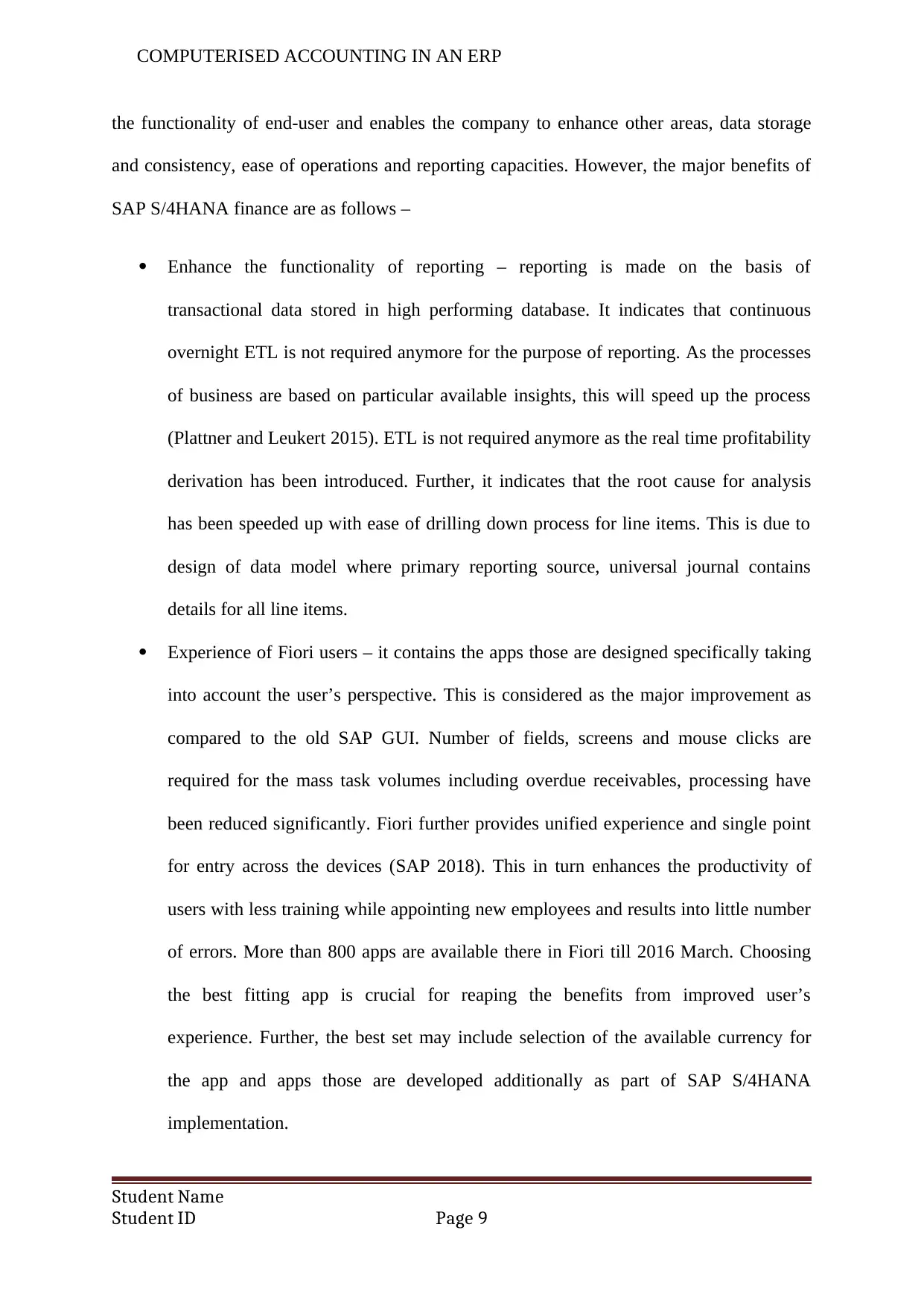
COMPUTERISED ACCOUNTING IN AN ERP
the functionality of end-user and enables the company to enhance other areas, data storage
and consistency, ease of operations and reporting capacities. However, the major benefits of
SAP S/4HANA finance are as follows –
Enhance the functionality of reporting – reporting is made on the basis of
transactional data stored in high performing database. It indicates that continuous
overnight ETL is not required anymore for the purpose of reporting. As the processes
of business are based on particular available insights, this will speed up the process
(Plattner and Leukert 2015). ETL is not required anymore as the real time profitability
derivation has been introduced. Further, it indicates that the root cause for analysis
has been speeded up with ease of drilling down process for line items. This is due to
design of data model where primary reporting source, universal journal contains
details for all line items.
Experience of Fiori users – it contains the apps those are designed specifically taking
into account the user’s perspective. This is considered as the major improvement as
compared to the old SAP GUI. Number of fields, screens and mouse clicks are
required for the mass task volumes including overdue receivables, processing have
been reduced significantly. Fiori further provides unified experience and single point
for entry across the devices (SAP 2018). This in turn enhances the productivity of
users with less training while appointing new employees and results into little number
of errors. More than 800 apps are available there in Fiori till 2016 March. Choosing
the best fitting app is crucial for reaping the benefits from improved user’s
experience. Further, the best set may include selection of the available currency for
the app and apps those are developed additionally as part of SAP S/4HANA
implementation.
Student Name
Student ID Page 9
the functionality of end-user and enables the company to enhance other areas, data storage
and consistency, ease of operations and reporting capacities. However, the major benefits of
SAP S/4HANA finance are as follows –
Enhance the functionality of reporting – reporting is made on the basis of
transactional data stored in high performing database. It indicates that continuous
overnight ETL is not required anymore for the purpose of reporting. As the processes
of business are based on particular available insights, this will speed up the process
(Plattner and Leukert 2015). ETL is not required anymore as the real time profitability
derivation has been introduced. Further, it indicates that the root cause for analysis
has been speeded up with ease of drilling down process for line items. This is due to
design of data model where primary reporting source, universal journal contains
details for all line items.
Experience of Fiori users – it contains the apps those are designed specifically taking
into account the user’s perspective. This is considered as the major improvement as
compared to the old SAP GUI. Number of fields, screens and mouse clicks are
required for the mass task volumes including overdue receivables, processing have
been reduced significantly. Fiori further provides unified experience and single point
for entry across the devices (SAP 2018). This in turn enhances the productivity of
users with less training while appointing new employees and results into little number
of errors. More than 800 apps are available there in Fiori till 2016 March. Choosing
the best fitting app is crucial for reaping the benefits from improved user’s
experience. Further, the best set may include selection of the available currency for
the app and apps those are developed additionally as part of SAP S/4HANA
implementation.
Student Name
Student ID Page 9
Secure Best Marks with AI Grader
Need help grading? Try our AI Grader for instant feedback on your assignments.
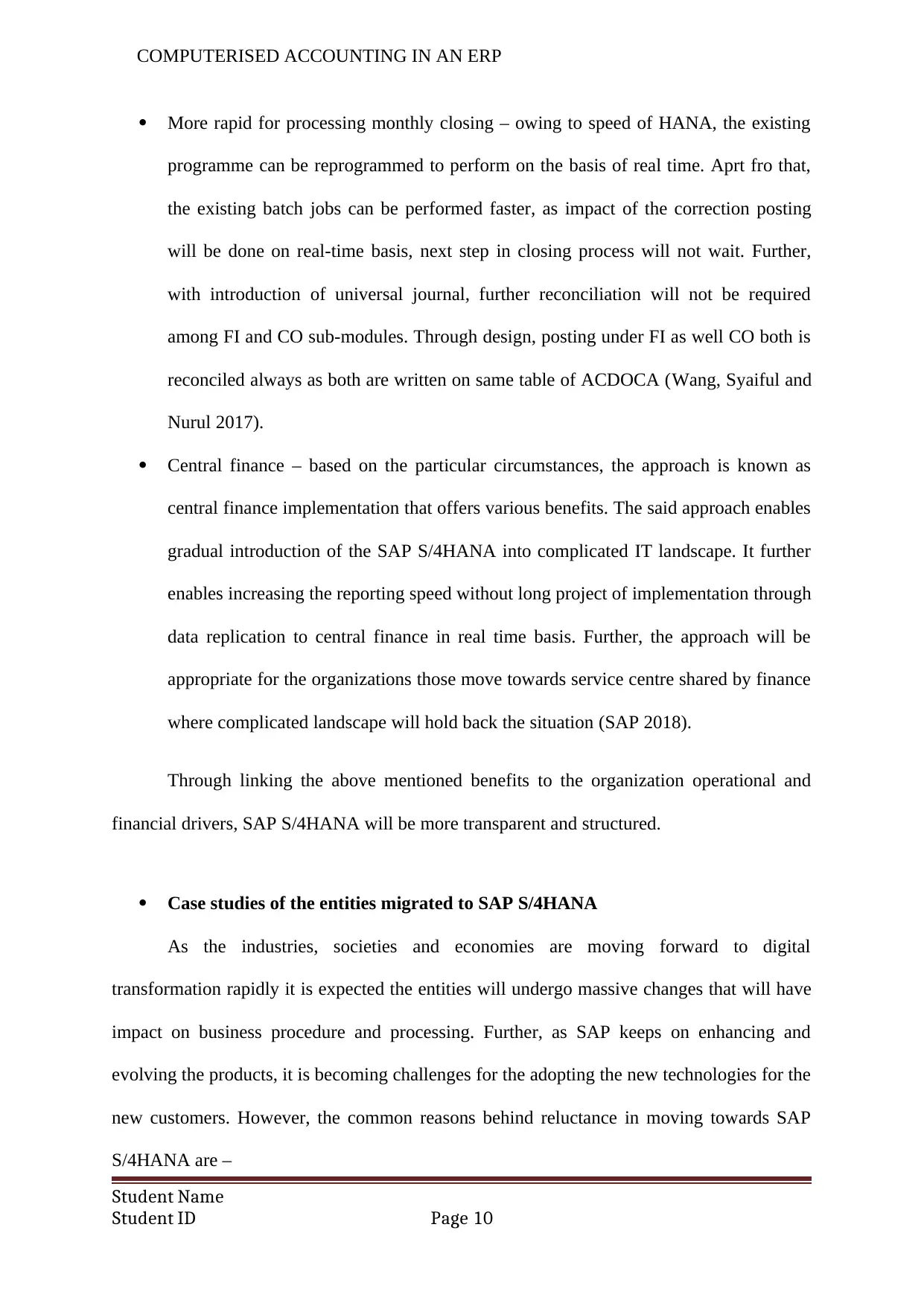
COMPUTERISED ACCOUNTING IN AN ERP
More rapid for processing monthly closing – owing to speed of HANA, the existing
programme can be reprogrammed to perform on the basis of real time. Aprt fro that,
the existing batch jobs can be performed faster, as impact of the correction posting
will be done on real-time basis, next step in closing process will not wait. Further,
with introduction of universal journal, further reconciliation will not be required
among FI and CO sub-modules. Through design, posting under FI as well CO both is
reconciled always as both are written on same table of ACDOCA (Wang, Syaiful and
Nurul 2017).
Central finance – based on the particular circumstances, the approach is known as
central finance implementation that offers various benefits. The said approach enables
gradual introduction of the SAP S/4HANA into complicated IT landscape. It further
enables increasing the reporting speed without long project of implementation through
data replication to central finance in real time basis. Further, the approach will be
appropriate for the organizations those move towards service centre shared by finance
where complicated landscape will hold back the situation (SAP 2018).
Through linking the above mentioned benefits to the organization operational and
financial drivers, SAP S/4HANA will be more transparent and structured.
Case studies of the entities migrated to SAP S/4HANA
As the industries, societies and economies are moving forward to digital
transformation rapidly it is expected the entities will undergo massive changes that will have
impact on business procedure and processing. Further, as SAP keeps on enhancing and
evolving the products, it is becoming challenges for the adopting the new technologies for the
new customers. However, the common reasons behind reluctance in moving towards SAP
S/4HANA are –
Student Name
Student ID Page 10
More rapid for processing monthly closing – owing to speed of HANA, the existing
programme can be reprogrammed to perform on the basis of real time. Aprt fro that,
the existing batch jobs can be performed faster, as impact of the correction posting
will be done on real-time basis, next step in closing process will not wait. Further,
with introduction of universal journal, further reconciliation will not be required
among FI and CO sub-modules. Through design, posting under FI as well CO both is
reconciled always as both are written on same table of ACDOCA (Wang, Syaiful and
Nurul 2017).
Central finance – based on the particular circumstances, the approach is known as
central finance implementation that offers various benefits. The said approach enables
gradual introduction of the SAP S/4HANA into complicated IT landscape. It further
enables increasing the reporting speed without long project of implementation through
data replication to central finance in real time basis. Further, the approach will be
appropriate for the organizations those move towards service centre shared by finance
where complicated landscape will hold back the situation (SAP 2018).
Through linking the above mentioned benefits to the organization operational and
financial drivers, SAP S/4HANA will be more transparent and structured.
Case studies of the entities migrated to SAP S/4HANA
As the industries, societies and economies are moving forward to digital
transformation rapidly it is expected the entities will undergo massive changes that will have
impact on business procedure and processing. Further, as SAP keeps on enhancing and
evolving the products, it is becoming challenges for the adopting the new technologies for the
new customers. However, the common reasons behind reluctance in moving towards SAP
S/4HANA are –
Student Name
Student ID Page 10
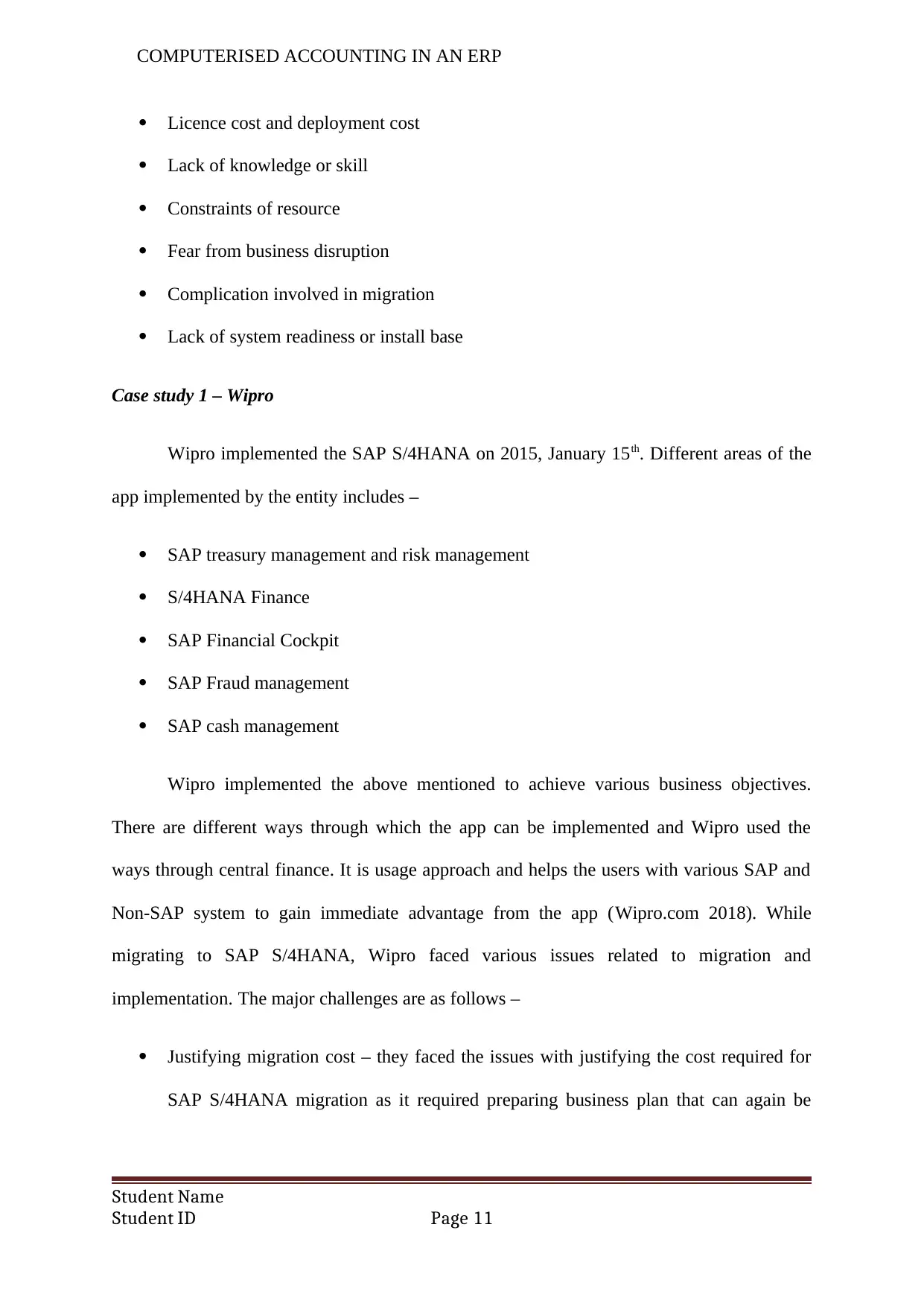
COMPUTERISED ACCOUNTING IN AN ERP
Licence cost and deployment cost
Lack of knowledge or skill
Constraints of resource
Fear from business disruption
Complication involved in migration
Lack of system readiness or install base
Case study 1 – Wipro
Wipro implemented the SAP S/4HANA on 2015, January 15th. Different areas of the
app implemented by the entity includes –
SAP treasury management and risk management
S/4HANA Finance
SAP Financial Cockpit
SAP Fraud management
SAP cash management
Wipro implemented the above mentioned to achieve various business objectives.
There are different ways through which the app can be implemented and Wipro used the
ways through central finance. It is usage approach and helps the users with various SAP and
Non-SAP system to gain immediate advantage from the app (Wipro.com 2018). While
migrating to SAP S/4HANA, Wipro faced various issues related to migration and
implementation. The major challenges are as follows –
Justifying migration cost – they faced the issues with justifying the cost required for
SAP S/4HANA migration as it required preparing business plan that can again be
Student Name
Student ID Page 11
Licence cost and deployment cost
Lack of knowledge or skill
Constraints of resource
Fear from business disruption
Complication involved in migration
Lack of system readiness or install base
Case study 1 – Wipro
Wipro implemented the SAP S/4HANA on 2015, January 15th. Different areas of the
app implemented by the entity includes –
SAP treasury management and risk management
S/4HANA Finance
SAP Financial Cockpit
SAP Fraud management
SAP cash management
Wipro implemented the above mentioned to achieve various business objectives.
There are different ways through which the app can be implemented and Wipro used the
ways through central finance. It is usage approach and helps the users with various SAP and
Non-SAP system to gain immediate advantage from the app (Wipro.com 2018). While
migrating to SAP S/4HANA, Wipro faced various issues related to migration and
implementation. The major challenges are as follows –
Justifying migration cost – they faced the issues with justifying the cost required for
SAP S/4HANA migration as it required preparing business plan that can again be
Student Name
Student ID Page 11
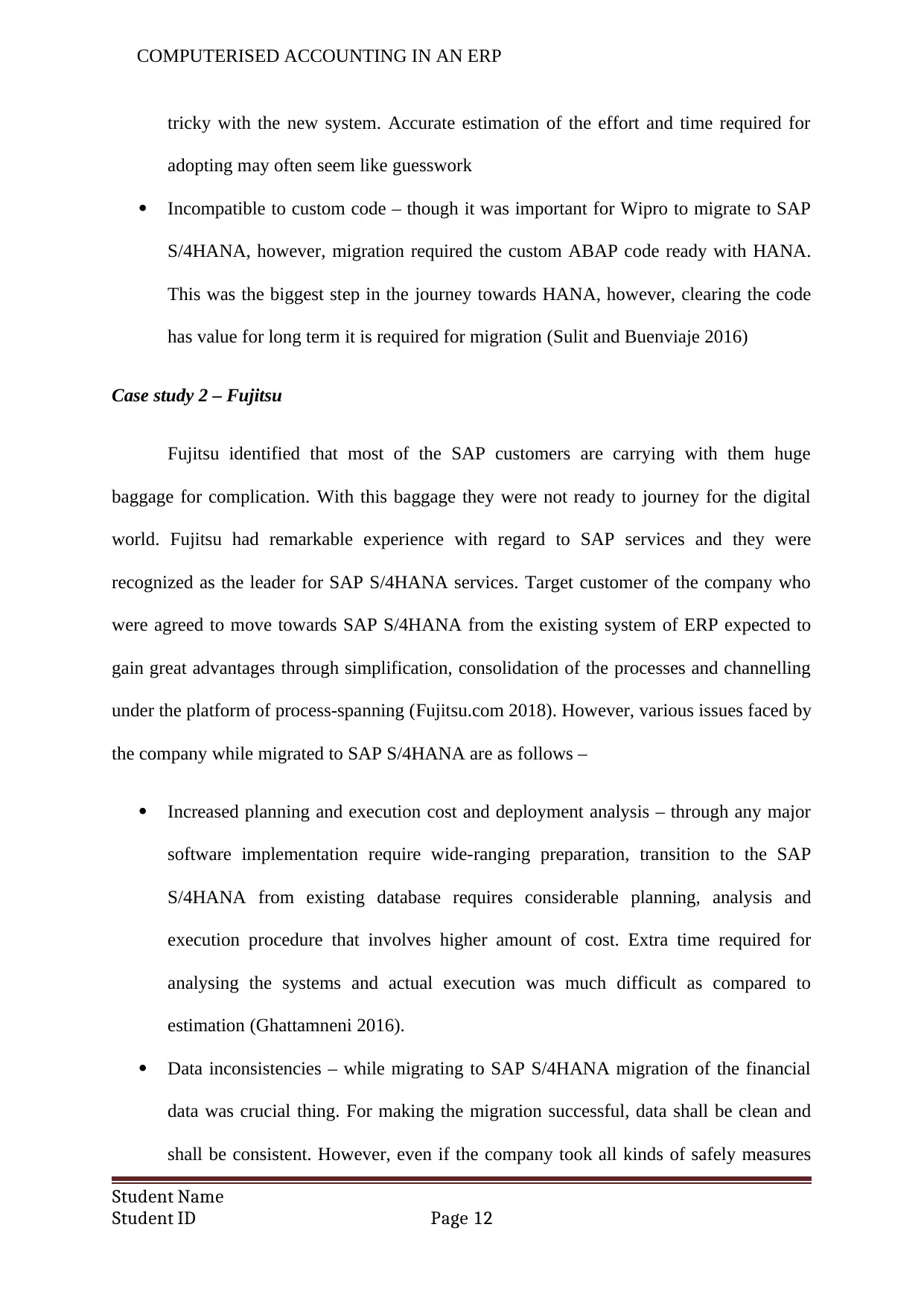
COMPUTERISED ACCOUNTING IN AN ERP
tricky with the new system. Accurate estimation of the effort and time required for
adopting may often seem like guesswork
Incompatible to custom code – though it was important for Wipro to migrate to SAP
S/4HANA, however, migration required the custom ABAP code ready with HANA.
This was the biggest step in the journey towards HANA, however, clearing the code
has value for long term it is required for migration (Sulit and Buenviaje 2016)
Case study 2 – Fujitsu
Fujitsu identified that most of the SAP customers are carrying with them huge
baggage for complication. With this baggage they were not ready to journey for the digital
world. Fujitsu had remarkable experience with regard to SAP services and they were
recognized as the leader for SAP S/4HANA services. Target customer of the company who
were agreed to move towards SAP S/4HANA from the existing system of ERP expected to
gain great advantages through simplification, consolidation of the processes and channelling
under the platform of process-spanning (Fujitsu.com 2018). However, various issues faced by
the company while migrated to SAP S/4HANA are as follows –
Increased planning and execution cost and deployment analysis – through any major
software implementation require wide-ranging preparation, transition to the SAP
S/4HANA from existing database requires considerable planning, analysis and
execution procedure that involves higher amount of cost. Extra time required for
analysing the systems and actual execution was much difficult as compared to
estimation (Ghattamneni 2016).
Data inconsistencies – while migrating to SAP S/4HANA migration of the financial
data was crucial thing. For making the migration successful, data shall be clean and
shall be consistent. However, even if the company took all kinds of safely measures
Student Name
Student ID Page 12
tricky with the new system. Accurate estimation of the effort and time required for
adopting may often seem like guesswork
Incompatible to custom code – though it was important for Wipro to migrate to SAP
S/4HANA, however, migration required the custom ABAP code ready with HANA.
This was the biggest step in the journey towards HANA, however, clearing the code
has value for long term it is required for migration (Sulit and Buenviaje 2016)
Case study 2 – Fujitsu
Fujitsu identified that most of the SAP customers are carrying with them huge
baggage for complication. With this baggage they were not ready to journey for the digital
world. Fujitsu had remarkable experience with regard to SAP services and they were
recognized as the leader for SAP S/4HANA services. Target customer of the company who
were agreed to move towards SAP S/4HANA from the existing system of ERP expected to
gain great advantages through simplification, consolidation of the processes and channelling
under the platform of process-spanning (Fujitsu.com 2018). However, various issues faced by
the company while migrated to SAP S/4HANA are as follows –
Increased planning and execution cost and deployment analysis – through any major
software implementation require wide-ranging preparation, transition to the SAP
S/4HANA from existing database requires considerable planning, analysis and
execution procedure that involves higher amount of cost. Extra time required for
analysing the systems and actual execution was much difficult as compared to
estimation (Ghattamneni 2016).
Data inconsistencies – while migrating to SAP S/4HANA migration of the financial
data was crucial thing. For making the migration successful, data shall be clean and
shall be consistent. However, even if the company took all kinds of safely measures
Student Name
Student ID Page 12
Paraphrase This Document
Need a fresh take? Get an instant paraphrase of this document with our AI Paraphraser
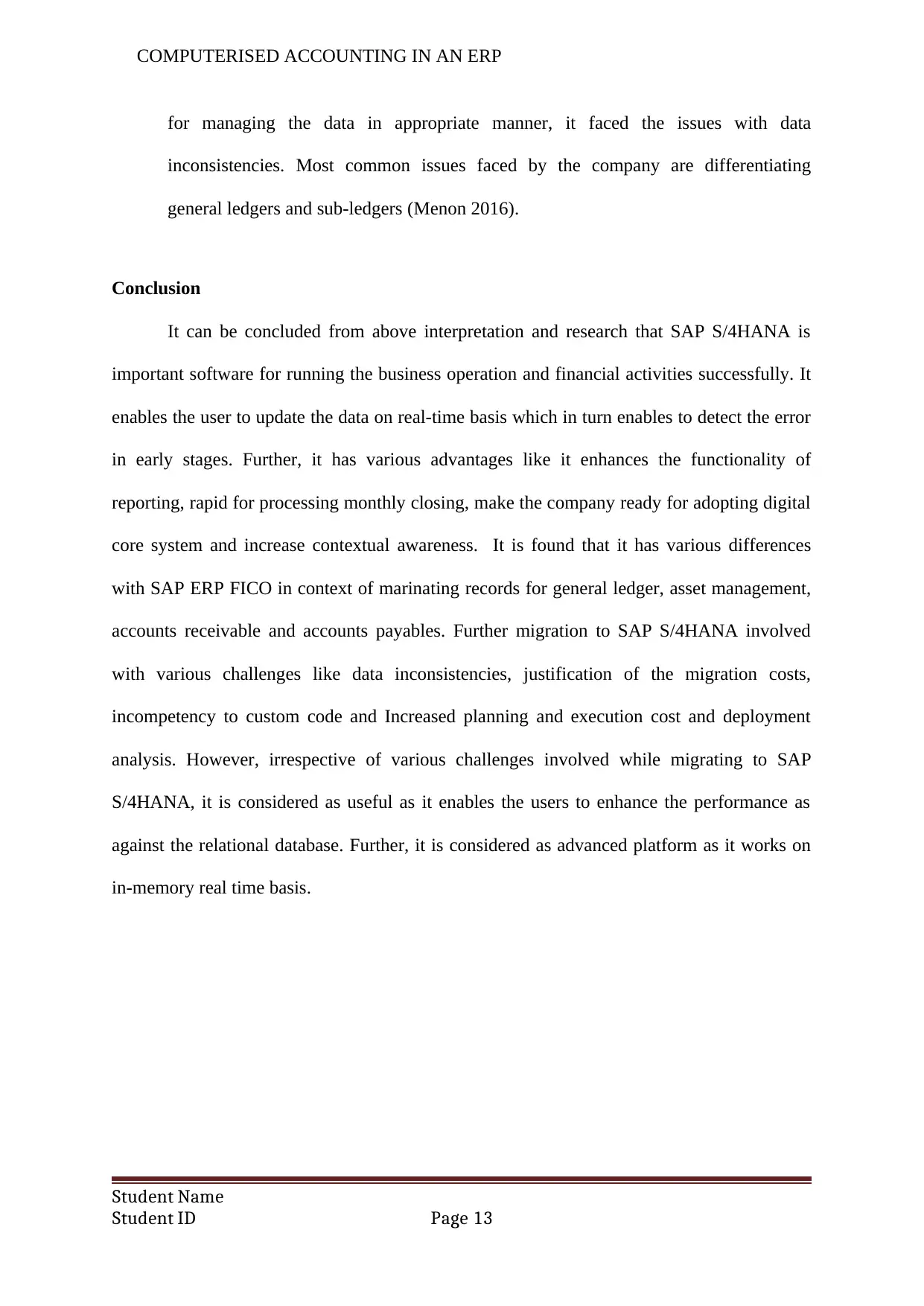
COMPUTERISED ACCOUNTING IN AN ERP
for managing the data in appropriate manner, it faced the issues with data
inconsistencies. Most common issues faced by the company are differentiating
general ledgers and sub-ledgers (Menon 2016).
Conclusion
It can be concluded from above interpretation and research that SAP S/4HANA is
important software for running the business operation and financial activities successfully. It
enables the user to update the data on real-time basis which in turn enables to detect the error
in early stages. Further, it has various advantages like it enhances the functionality of
reporting, rapid for processing monthly closing, make the company ready for adopting digital
core system and increase contextual awareness. It is found that it has various differences
with SAP ERP FICO in context of marinating records for general ledger, asset management,
accounts receivable and accounts payables. Further migration to SAP S/4HANA involved
with various challenges like data inconsistencies, justification of the migration costs,
incompetency to custom code and Increased planning and execution cost and deployment
analysis. However, irrespective of various challenges involved while migrating to SAP
S/4HANA, it is considered as useful as it enables the users to enhance the performance as
against the relational database. Further, it is considered as advanced platform as it works on
in-memory real time basis.
Student Name
Student ID Page 13
for managing the data in appropriate manner, it faced the issues with data
inconsistencies. Most common issues faced by the company are differentiating
general ledgers and sub-ledgers (Menon 2016).
Conclusion
It can be concluded from above interpretation and research that SAP S/4HANA is
important software for running the business operation and financial activities successfully. It
enables the user to update the data on real-time basis which in turn enables to detect the error
in early stages. Further, it has various advantages like it enhances the functionality of
reporting, rapid for processing monthly closing, make the company ready for adopting digital
core system and increase contextual awareness. It is found that it has various differences
with SAP ERP FICO in context of marinating records for general ledger, asset management,
accounts receivable and accounts payables. Further migration to SAP S/4HANA involved
with various challenges like data inconsistencies, justification of the migration costs,
incompetency to custom code and Increased planning and execution cost and deployment
analysis. However, irrespective of various challenges involved while migrating to SAP
S/4HANA, it is considered as useful as it enables the users to enhance the performance as
against the relational database. Further, it is considered as advanced platform as it works on
in-memory real time basis.
Student Name
Student ID Page 13
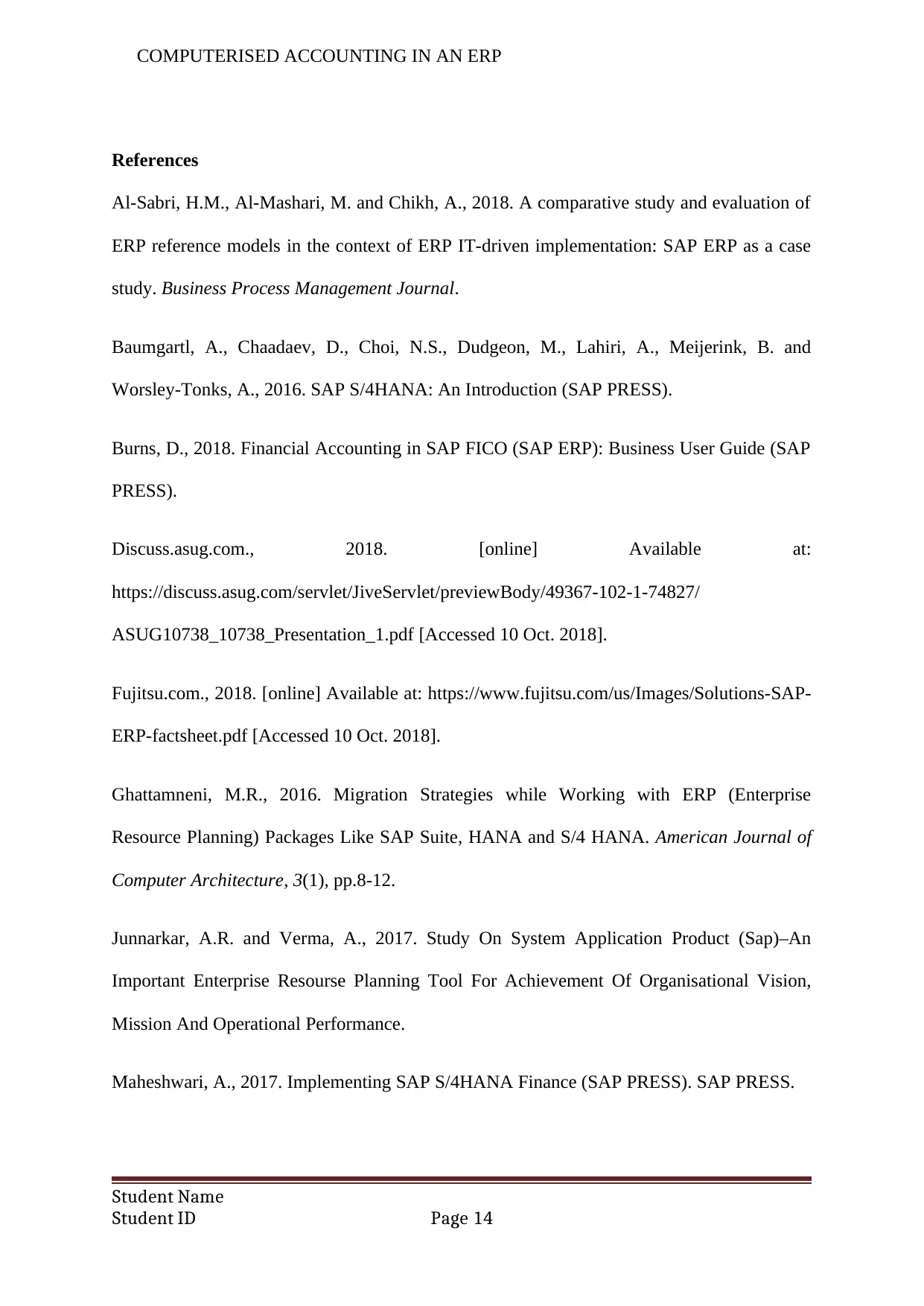
COMPUTERISED ACCOUNTING IN AN ERP
References
Al-Sabri, H.M., Al-Mashari, M. and Chikh, A., 2018. A comparative study and evaluation of
ERP reference models in the context of ERP IT-driven implementation: SAP ERP as a case
study. Business Process Management Journal.
Baumgartl, A., Chaadaev, D., Choi, N.S., Dudgeon, M., Lahiri, A., Meijerink, B. and
Worsley-Tonks, A., 2016. SAP S/4HANA: An Introduction (SAP PRESS).
Burns, D., 2018. Financial Accounting in SAP FICO (SAP ERP): Business User Guide (SAP
PRESS).
Discuss.asug.com., 2018. [online] Available at:
https://discuss.asug.com/servlet/JiveServlet/previewBody/49367-102-1-74827/
ASUG10738_10738_Presentation_1.pdf [Accessed 10 Oct. 2018].
Fujitsu.com., 2018. [online] Available at: https://www.fujitsu.com/us/Images/Solutions-SAP-
ERP-factsheet.pdf [Accessed 10 Oct. 2018].
Ghattamneni, M.R., 2016. Migration Strategies while Working with ERP (Enterprise
Resource Planning) Packages Like SAP Suite, HANA and S/4 HANA. American Journal of
Computer Architecture, 3(1), pp.8-12.
Junnarkar, A.R. and Verma, A., 2017. Study On System Application Product (Sap)–An
Important Enterprise Resourse Planning Tool For Achievement Of Organisational Vision,
Mission And Operational Performance.
Maheshwari, A., 2017. Implementing SAP S/4HANA Finance (SAP PRESS). SAP PRESS.
Student Name
Student ID Page 14
References
Al-Sabri, H.M., Al-Mashari, M. and Chikh, A., 2018. A comparative study and evaluation of
ERP reference models in the context of ERP IT-driven implementation: SAP ERP as a case
study. Business Process Management Journal.
Baumgartl, A., Chaadaev, D., Choi, N.S., Dudgeon, M., Lahiri, A., Meijerink, B. and
Worsley-Tonks, A., 2016. SAP S/4HANA: An Introduction (SAP PRESS).
Burns, D., 2018. Financial Accounting in SAP FICO (SAP ERP): Business User Guide (SAP
PRESS).
Discuss.asug.com., 2018. [online] Available at:
https://discuss.asug.com/servlet/JiveServlet/previewBody/49367-102-1-74827/
ASUG10738_10738_Presentation_1.pdf [Accessed 10 Oct. 2018].
Fujitsu.com., 2018. [online] Available at: https://www.fujitsu.com/us/Images/Solutions-SAP-
ERP-factsheet.pdf [Accessed 10 Oct. 2018].
Ghattamneni, M.R., 2016. Migration Strategies while Working with ERP (Enterprise
Resource Planning) Packages Like SAP Suite, HANA and S/4 HANA. American Journal of
Computer Architecture, 3(1), pp.8-12.
Junnarkar, A.R. and Verma, A., 2017. Study On System Application Product (Sap)–An
Important Enterprise Resourse Planning Tool For Achievement Of Organisational Vision,
Mission And Operational Performance.
Maheshwari, A., 2017. Implementing SAP S/4HANA Finance (SAP PRESS). SAP PRESS.
Student Name
Student ID Page 14
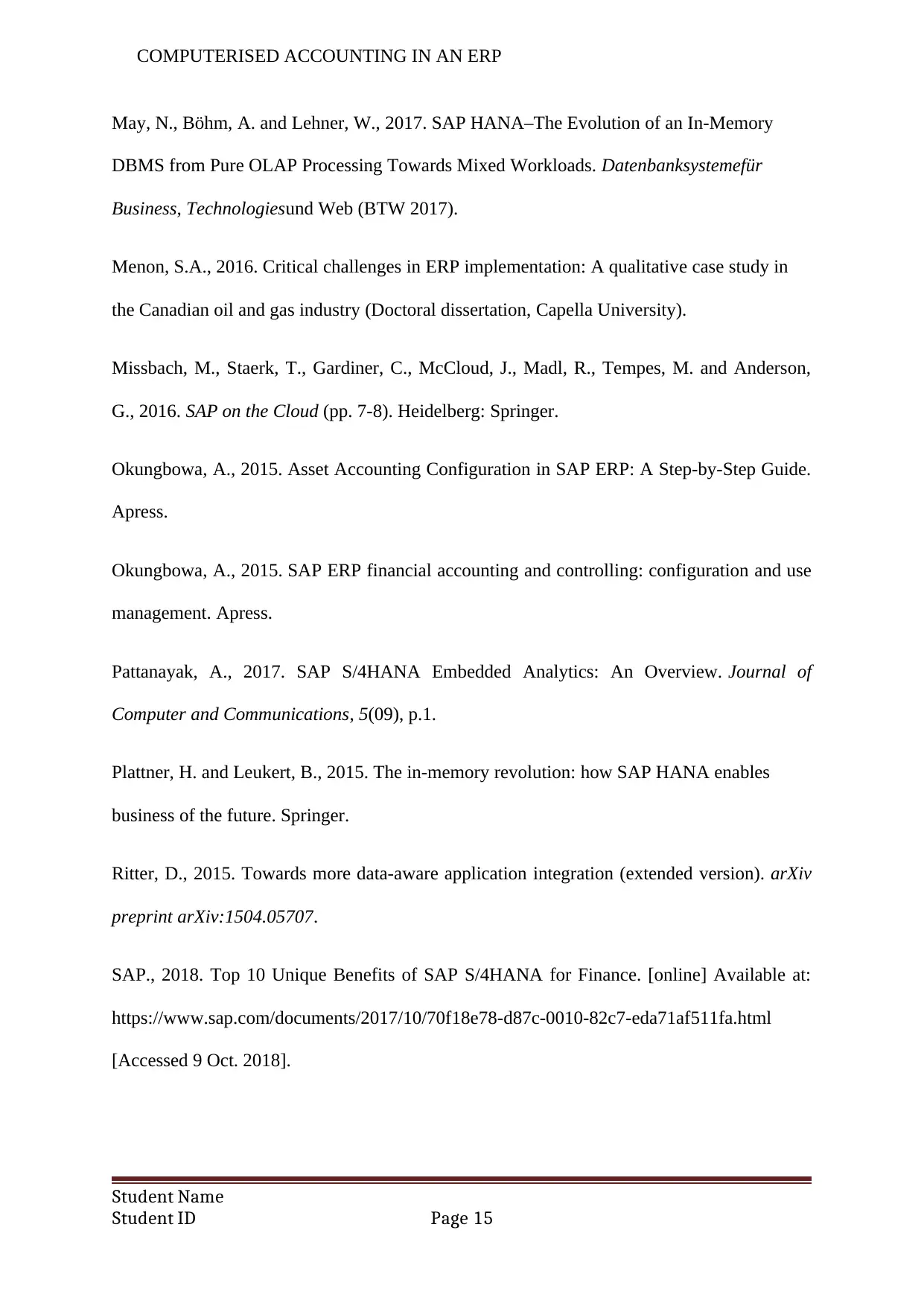
COMPUTERISED ACCOUNTING IN AN ERP
May, N., Böhm, A. and Lehner, W., 2017. SAP HANA–The Evolution of an In-Memory
DBMS from Pure OLAP Processing Towards Mixed Workloads. Datenbanksystemefür
Business, Technologiesund Web (BTW 2017).
Menon, S.A., 2016. Critical challenges in ERP implementation: A qualitative case study in
the Canadian oil and gas industry (Doctoral dissertation, Capella University).
Missbach, M., Staerk, T., Gardiner, C., McCloud, J., Madl, R., Tempes, M. and Anderson,
G., 2016. SAP on the Cloud (pp. 7-8). Heidelberg: Springer.
Okungbowa, A., 2015. Asset Accounting Configuration in SAP ERP: A Step-by-Step Guide.
Apress.
Okungbowa, A., 2015. SAP ERP financial accounting and controlling: configuration and use
management. Apress.
Pattanayak, A., 2017. SAP S/4HANA Embedded Analytics: An Overview. Journal of
Computer and Communications, 5(09), p.1.
Plattner, H. and Leukert, B., 2015. The in-memory revolution: how SAP HANA enables
business of the future. Springer.
Ritter, D., 2015. Towards more data-aware application integration (extended version). arXiv
preprint arXiv:1504.05707.
SAP., 2018. Top 10 Unique Benefits of SAP S/4HANA for Finance. [online] Available at:
https://www.sap.com/documents/2017/10/70f18e78-d87c-0010-82c7-eda71af511fa.html
[Accessed 9 Oct. 2018].
Student Name
Student ID Page 15
May, N., Böhm, A. and Lehner, W., 2017. SAP HANA–The Evolution of an In-Memory
DBMS from Pure OLAP Processing Towards Mixed Workloads. Datenbanksystemefür
Business, Technologiesund Web (BTW 2017).
Menon, S.A., 2016. Critical challenges in ERP implementation: A qualitative case study in
the Canadian oil and gas industry (Doctoral dissertation, Capella University).
Missbach, M., Staerk, T., Gardiner, C., McCloud, J., Madl, R., Tempes, M. and Anderson,
G., 2016. SAP on the Cloud (pp. 7-8). Heidelberg: Springer.
Okungbowa, A., 2015. Asset Accounting Configuration in SAP ERP: A Step-by-Step Guide.
Apress.
Okungbowa, A., 2015. SAP ERP financial accounting and controlling: configuration and use
management. Apress.
Pattanayak, A., 2017. SAP S/4HANA Embedded Analytics: An Overview. Journal of
Computer and Communications, 5(09), p.1.
Plattner, H. and Leukert, B., 2015. The in-memory revolution: how SAP HANA enables
business of the future. Springer.
Ritter, D., 2015. Towards more data-aware application integration (extended version). arXiv
preprint arXiv:1504.05707.
SAP., 2018. Top 10 Unique Benefits of SAP S/4HANA for Finance. [online] Available at:
https://www.sap.com/documents/2017/10/70f18e78-d87c-0010-82c7-eda71af511fa.html
[Accessed 9 Oct. 2018].
Student Name
Student ID Page 15
Secure Best Marks with AI Grader
Need help grading? Try our AI Grader for instant feedback on your assignments.
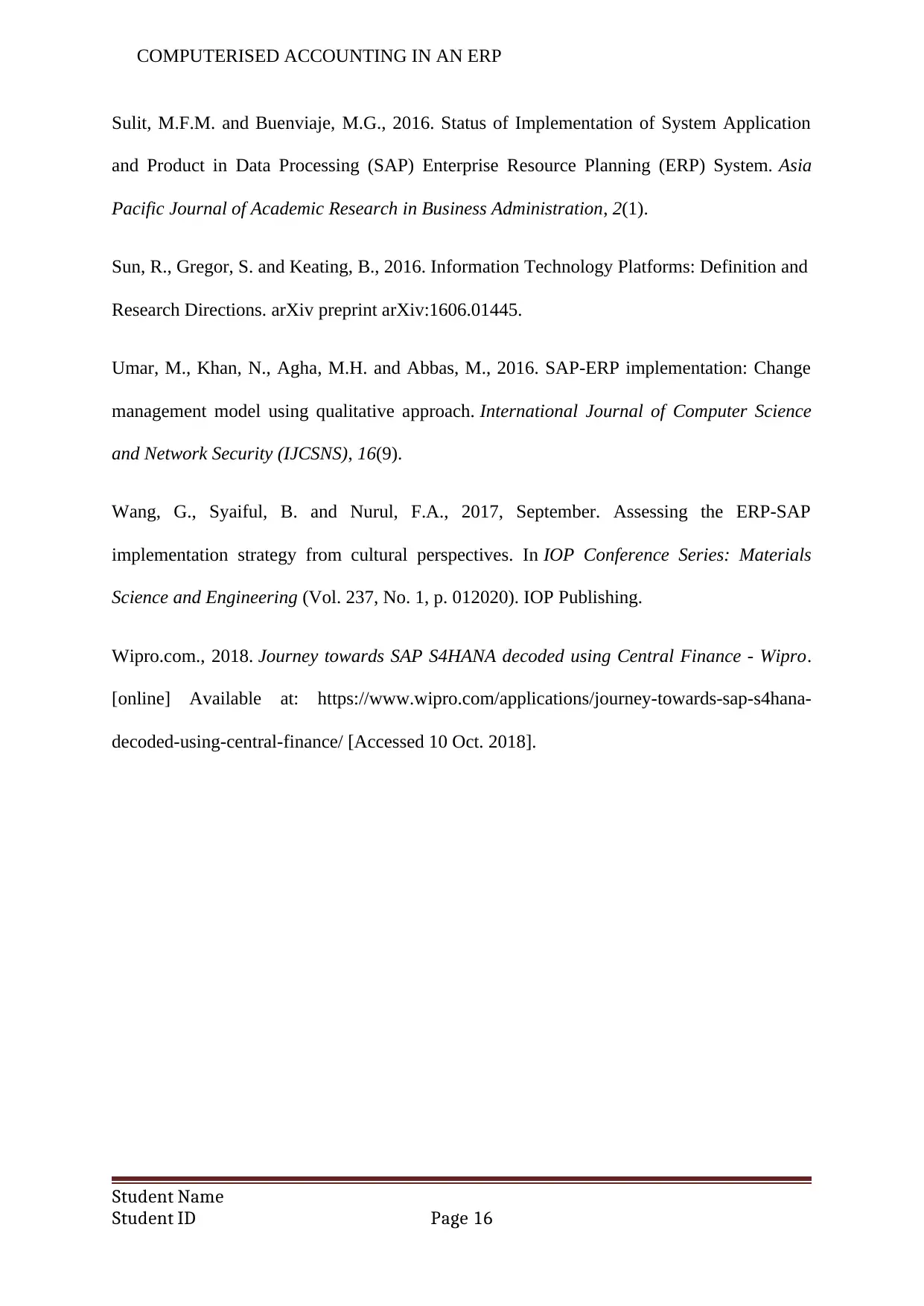
COMPUTERISED ACCOUNTING IN AN ERP
Sulit, M.F.M. and Buenviaje, M.G., 2016. Status of Implementation of System Application
and Product in Data Processing (SAP) Enterprise Resource Planning (ERP) System. Asia
Pacific Journal of Academic Research in Business Administration, 2(1).
Sun, R., Gregor, S. and Keating, B., 2016. Information Technology Platforms: Definition and
Research Directions. arXiv preprint arXiv:1606.01445.
Umar, M., Khan, N., Agha, M.H. and Abbas, M., 2016. SAP-ERP implementation: Change
management model using qualitative approach. International Journal of Computer Science
and Network Security (IJCSNS), 16(9).
Wang, G., Syaiful, B. and Nurul, F.A., 2017, September. Assessing the ERP-SAP
implementation strategy from cultural perspectives. In IOP Conference Series: Materials
Science and Engineering (Vol. 237, No. 1, p. 012020). IOP Publishing.
Wipro.com., 2018. Journey towards SAP S4HANA decoded using Central Finance - Wipro.
[online] Available at: https://www.wipro.com/applications/journey-towards-sap-s4hana-
decoded-using-central-finance/ [Accessed 10 Oct. 2018].
Student Name
Student ID Page 16
Sulit, M.F.M. and Buenviaje, M.G., 2016. Status of Implementation of System Application
and Product in Data Processing (SAP) Enterprise Resource Planning (ERP) System. Asia
Pacific Journal of Academic Research in Business Administration, 2(1).
Sun, R., Gregor, S. and Keating, B., 2016. Information Technology Platforms: Definition and
Research Directions. arXiv preprint arXiv:1606.01445.
Umar, M., Khan, N., Agha, M.H. and Abbas, M., 2016. SAP-ERP implementation: Change
management model using qualitative approach. International Journal of Computer Science
and Network Security (IJCSNS), 16(9).
Wang, G., Syaiful, B. and Nurul, F.A., 2017, September. Assessing the ERP-SAP
implementation strategy from cultural perspectives. In IOP Conference Series: Materials
Science and Engineering (Vol. 237, No. 1, p. 012020). IOP Publishing.
Wipro.com., 2018. Journey towards SAP S4HANA decoded using Central Finance - Wipro.
[online] Available at: https://www.wipro.com/applications/journey-towards-sap-s4hana-
decoded-using-central-finance/ [Accessed 10 Oct. 2018].
Student Name
Student ID Page 16
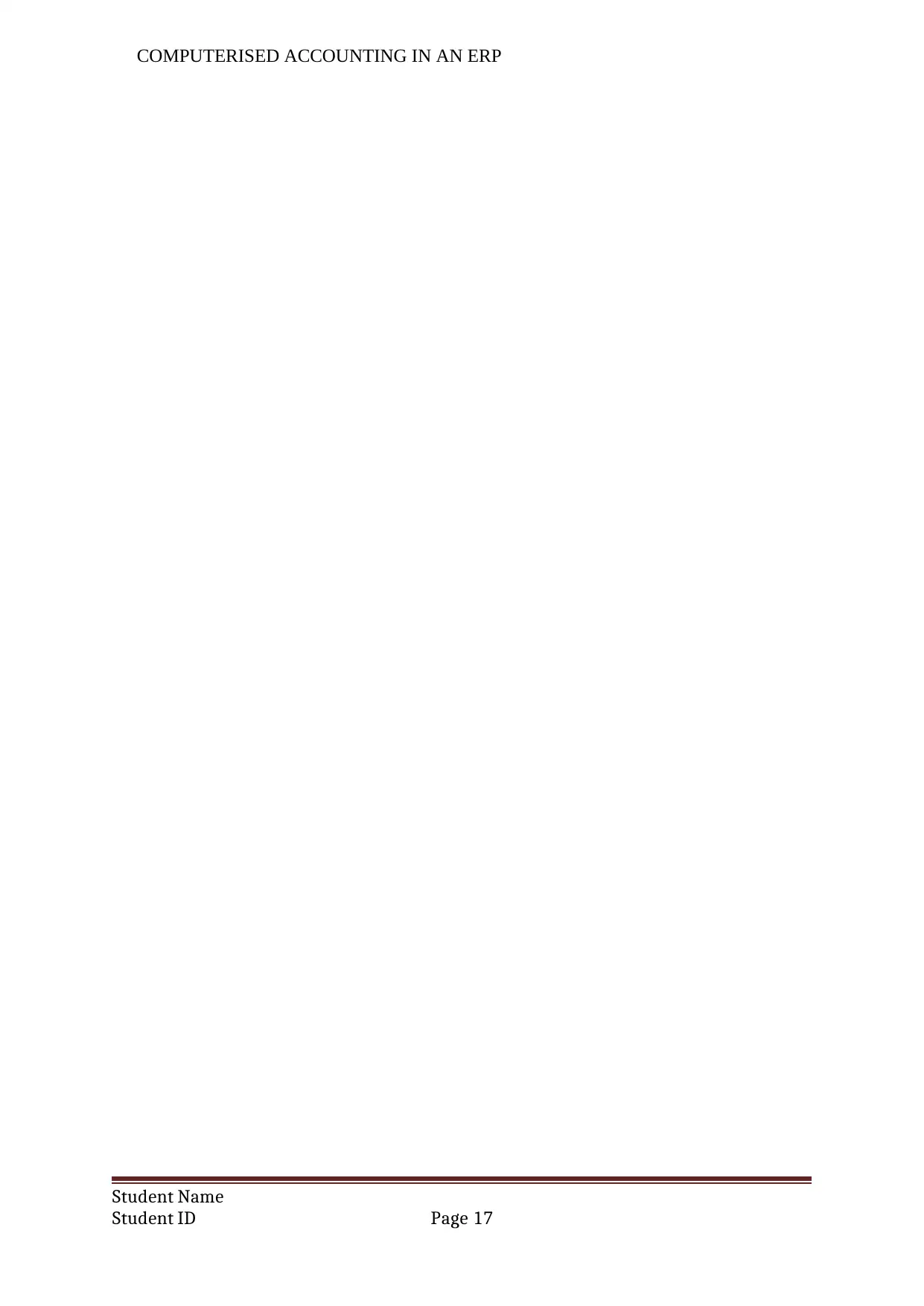
COMPUTERISED ACCOUNTING IN AN ERP
Student Name
Student ID Page 17
Student Name
Student ID Page 17
1 out of 18
Related Documents
Your All-in-One AI-Powered Toolkit for Academic Success.
+13062052269
info@desklib.com
Available 24*7 on WhatsApp / Email
![[object Object]](/_next/static/media/star-bottom.7253800d.svg)
Unlock your academic potential
© 2024 | Zucol Services PVT LTD | All rights reserved.





